The Future of Smart Contract Platforms

HashKey Capital* is an institutional asset manager that invests exclusively in blockchain technology and digital assets. As one of the most experienced blockchain investors based in Asia, the HashKey Capital team has deep knowledge of the blockchain ecosystem in the region and has built a network connecting entrepreneurs, investors, developers, community participants and regulators. HashKey Capital is affiliated with HashKey Group, a digital asset management and financial services institution in Asia.*
Follow HashKey Capital on Twitter.
HashKey Capital Research* is a multidisciplinary team that focuses on blockchain research. Led by Research Director Jupiter Zheng, the team’s mission is to research and build reports that will help HashKey Group, investors and the public make sense of this new asest class and help drive informed investments decisions.*
Follow HashKey Capital Research on Twitter.
Author: Henrique Centieiro, Senior Research Manager, HashKey Capital
Having first learnt about Bitcoin back in 2013, Henri was immediately fascinated by the technology behind and decided to dive deeper. His mission is to leverage blockchain technology to educate, connect and build projects that can change the world for the better. Prior to HashKey, he worked as a Blockchain Project Manager in 2017-2021, supporting the implementation of different blockchain projects, including trade finance applications. With 4 years of experience educating students about blockchain and FinTech at various universities and on online platforms, he also enjoys writing, having published 2 blockchain themed books. He is also a Certified Blockchain Developer, Certified Blockchain Architect, Certified Corda Developer, Certified AWS Architect, Certified AWS Developer, Certified SysOps Admin and a Scrum Master.
Introduction
Privacy is essential to ensure basic safety. Privacy is in fact a fundamental human right recognized by the UN Declaration of Human Rights, and it is important to ensure human dignity, freedom of speech, and freedom of association. Imagine for a second that all you have is available online for anyone to see:your bank transactions, your salary, your investments, property, artwork, how much did you spend at the restaurant, how much money you have (or don’t have). Does it sound right?
Bitcoin and subsequent cryptocurrencies are amazing tools to protect human rights: they are censorship-resistant, and they cannot be created, destroyed, or controlled by controlled in anyone’s favor. They are open to everyone and provide equality of opportunity. In the modern world, cryptocurrencies are the only tool that provides total freedom to transact. However, to achieve this, blockchains need to be decentralized and permissionless, meaning that the data is transparent to everyone and is shared across a large number of miners or nodes. Where does privacy fit here?
In a world that is moving to Web3, the value of privacy networks is of utmost importance. Ignoring smart contract privacy networks today is like ignoring SSL encryption on the internet 20 years ago. Everything we do on the internet is encrypted — emails, bank transactions, online shopping — and we probably wouldn’t do these things without encryption and data protection. Now entering the Web3 world, the next phase of the internet, we also need to ensure data privacy.
In this report, we will look at 5 privacy smart contracts networks — Secret, Oasis, Horizen, Phala, Dero– and give you a better overview of the technologies that will help the Web3 to be more private. Which one is going to be the next privacy standard we don’t know… but we do know that there are rock-solid projects with strong teams tackling the privacy issue.
How important is privacy? Very important.
Privacy benefits everyone. If you have a bank account, you want your balance, transactions, and salary to be kept private. If you own artworks, you may want them to keep private on the walls of your home. If you have medical records, you probably want to keep them private too. As a business, you may also want to keep some of your transactions private. The users of a privacy smart contract network are any person interested in keeping some degree of privacy.
The number of Ethereum addresses that hodl at least 0.1 ETH (approx. $300) has been hitting new alltime highs. In March 2022, close to 7 million addresses held 0.1 ETH. This is great news for blockchain adoption but not so good news for the privacy world.
Privacy coins vs. smart contract privacy networks
Blockchains are inherently transparent. Although Bitcoin was very often associated with anonymity, the reality is that Bitcoin (and many other networks including Ethereum) are not anonymous at all. Instead, these networks are pseudonymous.
Every Ethereum wallet has an address that a priori is not associated with the real name of the owner, but if Alice sends, ETH, UST, or an NFT to Bob, Bob now knows Alice’s address and can check all her assets and all her previous transactions. There’s total transparency and total loss of privacy.
Let’s assume that Bob is a good guy but one day, Mallory discovers Alice’s address that contains 3 BAYC and 500 ETH and Mallory manages easily connect Alice’s wallet to her real identity because Alice is using one of those BAYC as her Twitter profile. Then, Mallory can easily launch a hacking attack to try to steal Alice’s private keys, or even worse, execute the “$5 wrench attack”. Nowadays, people with a significant amount of crypto assets are a honey pot for hackers that try to spear-fishing or physically target them. Having a significant amount of crypto assets in your wallet is pretty much the same aswalking around with your bank account balance written on your forehead.
Finally, people share a lot on social media and it’s very hard to hide your assets. For example, Snoop Dogg tweeted.
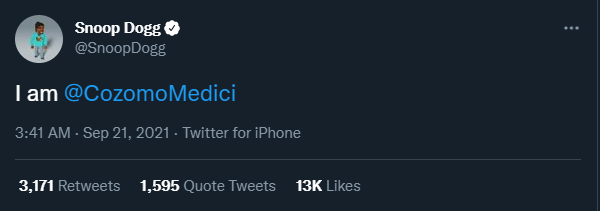
And after that, it’s fairly easy to find his OpenSea portfolio, his Ethereum address, and then check on dAppRadar that he has around $15.76M of assets in a single wallet.

We already know that some rappers like to flash their riches but… what if they want to protect their identities or some of their assets? It never crossed our minds to be able to look at someone else’s bank account but now we can have access to all their detailed transactions and assets.
How can we protect people’s privacy?
Have you seen all those people showing their ENS domain on their Twitter? They do it willingly for sure that that’s pretty much the same as posting online all the bank details.
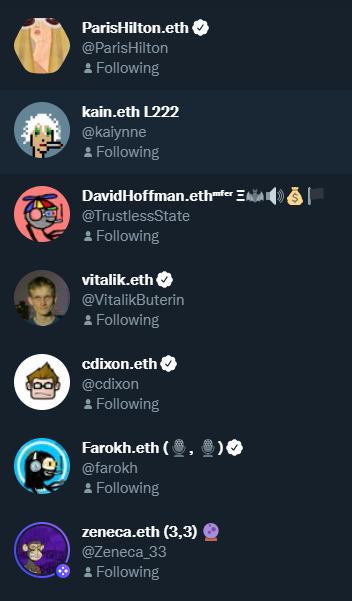
Privacy starts to be a big pain point considering that anyone can see any transaction of an address by having access to it or having access to the ENS domain - myaddress.eth. With the growing adoption of Web3.0 applications, people will want to protect their privacy.
One of the core components of blockchains is decentralization and people that have been developing dApps, know how important privacy is. However, it seems that last few years, as a side effect of decentralization and transparency, most blockchain protocols have been working against their user’s privacy.
How can we change this?
Different cryptocurrencies have been trying to solve privacy
Currently, the largest privacy coins by market capitalization are Zcash and Monero. These coins allow private and untraceable transactions by using technologies such as zero-knowledge proofs, stealth addresses, and ring signatures. While in Zcash’s case, the user can turn off the privacy features, Monero is inherently private. Law enforcement agencies, especially the IRS, have been trying to crack Monero and even offered a $625 000 bounty to anyone that could crack the network.
Although these blockchains do a great job protecting privacy, they don’t have any scripting functionality. Just like Bitcoin, they don’t allow the creation of complex smart contracts. Other Ethereum apps like Tornado Cash can obfuscate the transaction flow, but it’s far from keeping assets private. There comes the privacy smart contract networks. They allow the developers to build smart contracts and applications that go hand in hand with data privacy.

In this report, we will discuss only the smart contract networks. It’s also important to note that in most cases, private smart contract network native cryptocurrencies — for example SCRT in the Secret network, ROSE on Oasis, and ZEN on Horizen — are not privacy coins. Instead, only other assets that are created within these networks are private by using technologies such as private side chains, TEEs (Trusted Secure Environments), ZK-SNARKS, or homomorphic encryption. Later we will take a look at some examples.
These privacy technologies may be more common than you think. We all use TEEs every day for enhanced privacy. For example, when you use your biometrics (fingerprint) to unlock an app on your phone, the app doesn’t have access to the fingerprint but has the info from the TEE saying “this fingerprint is alright!”. The fingerprint details never get out of the TEE in your phone’s CPU.
The crypto world is switching towards privacy
Privacy-enabled coins and smart contract platforms have been outperforming the market, especially since countries and financial institutions have been imposing sanctions on Russia. Coincidence?
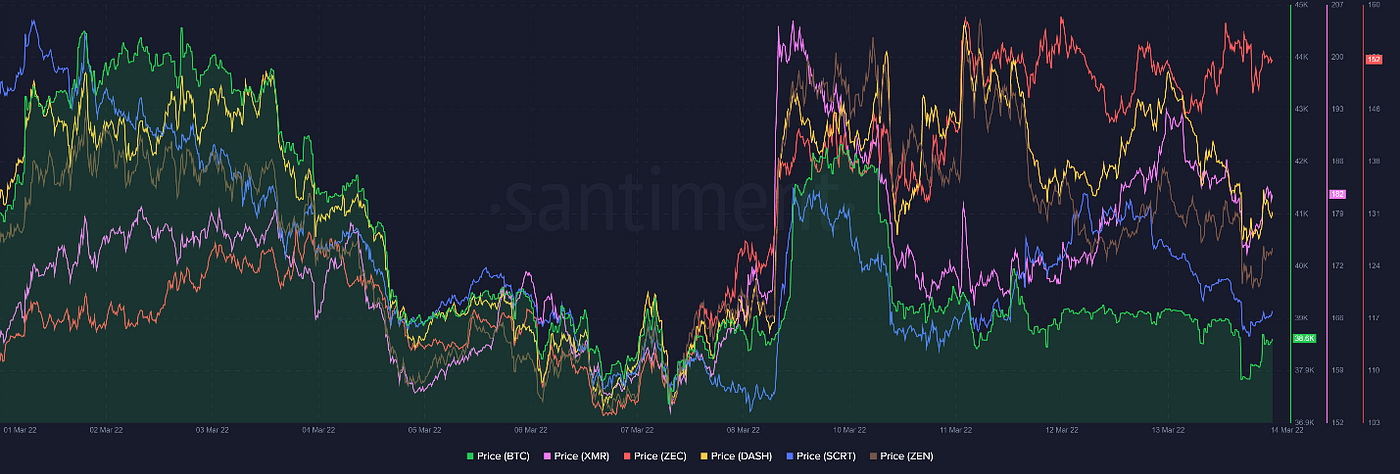
The chart illustrates well how much these networks have been outperforming our benchmark, in this case, Bitcoin.
Seeking more privacy is not the only driver for the market to adopt these networks. The number of developers, wallets, and TVL in these networks has been showing that the world is switching to the privacy networks, just the same way we have switched from ancient cave graffiti to writing who owns what in papyrus that the village headman would store.
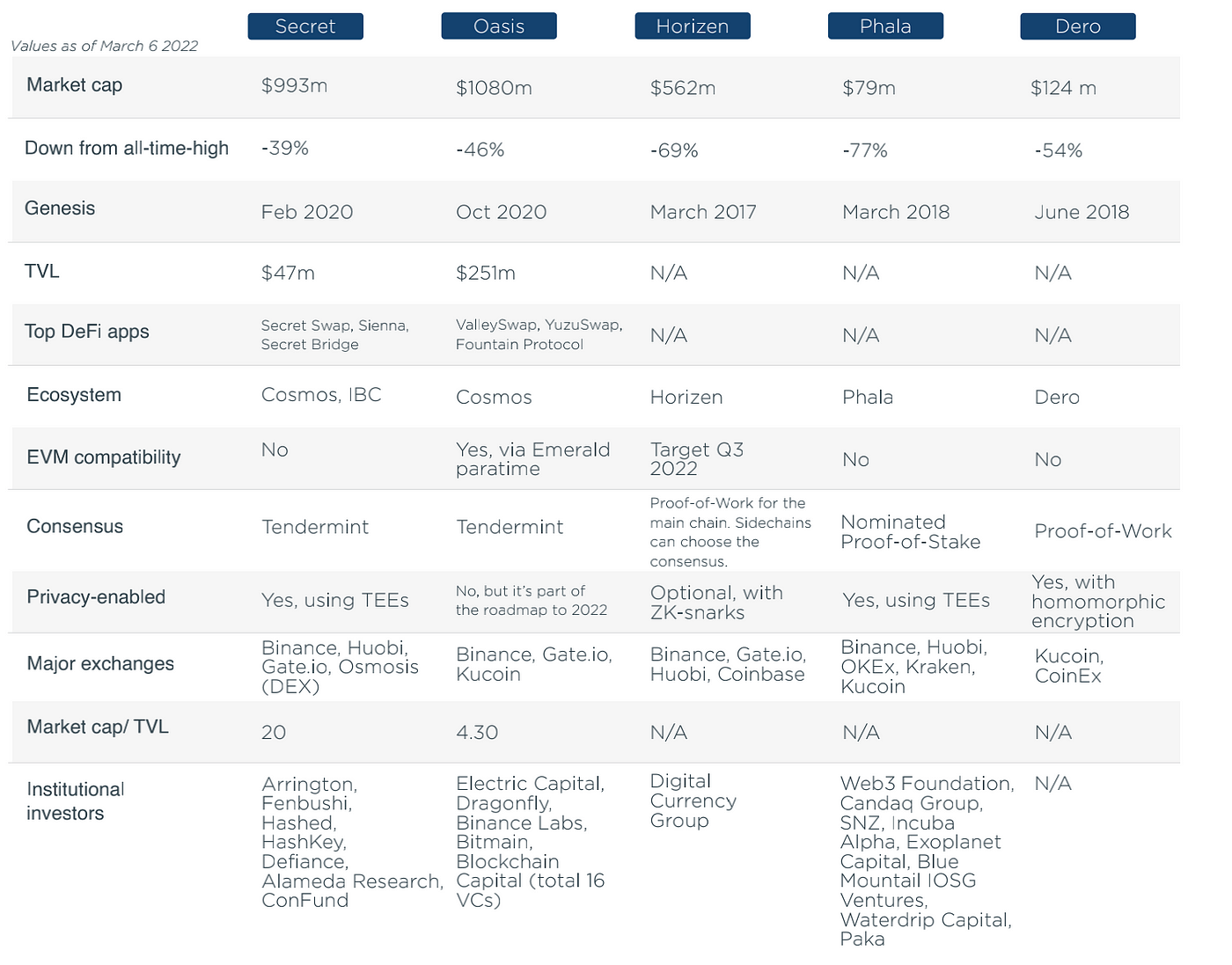
Different ways to achieve the same result
On permissioned enterprise blockchains, the answer to the privacy question is relatively simple. Technologies such as Corda, Hyperledger Fabric, or Quorum’s integration with Hyperledger Besu, allow data to be shared on a need-to-know basis or the creation of encrypted channels. Most times, most data is shared only with the nodes involved in that specific transaction.
On the other hand, public blockchains are permissionless by nature, meaning that anyone can join as a node/miner/validator. How can we keep a network fully open, decentralized, and permissionless but at the same time, keep the data private?
The different blockchain networks analyzed in this report use different encryption-enabled privacy mechanisms to provide the users with additional layers of privacy. The goal is the same: how to keep data and smart contract execution private while keeping the network permissionless and decentralized. How to allow a number of nodes/validators/miners to verify all the transactions while at the same time, hiding all the data from everyone, including those same nodes?
The networks that we have analyzed use very sophisticated ways of solving this problem. These solutions have design trade-offs and they may fit different use cases. It’s hard to say if there’s a winner among all these. I would say that all of them are big winners for being at the forefront of data privacy protection. They all use best-in-class security features. However, they also add complexity when compared to other blockchain networks that don’t need to worry about privacy.
When trying to choose a privacy network solution, developers need to take into account the network complexity, cost, technology readiness, scalability/latency, the level of decentralization, the risk of having to include irrelevant data in the payload, exactly what data is supposed to be kept private, and how these networks manage the access to data and private keys. These networks may require further engineering for maturity and prove that they can manage networks with a large dApp ecosystem.
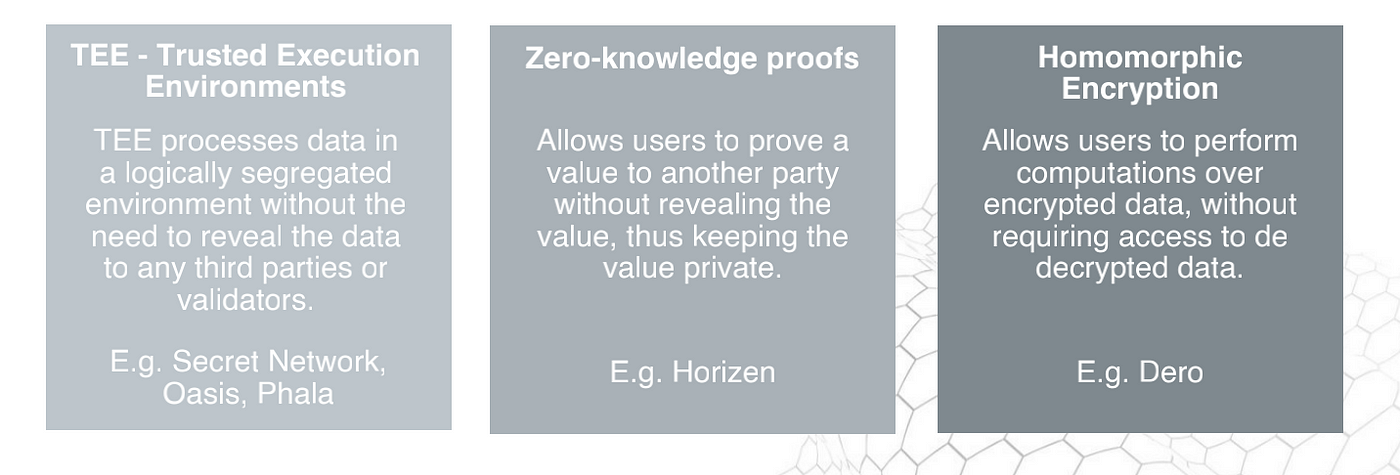
Note: In the next section of the report we will be analyzing the Secret Network, Oasis, Horizen Phala and Dero. Although we have tried to keep our approach consistent, some onchain analytics tools are not available to take a deeper look at all these networks, thus some of them may have a shorter analysis from our side.
Secret Network
Overview
According to Secret’s website, “Secret Network packages the smart contract execution of Ethereum, the transactional privacy of Monero, and interoperability offered by Cosmos SDK chains.” Secret started as Enigma in 2015 at MIT as an Ethereum L2, allowing privacy-preserving smart contracts.
On May 2020, Enigma rebranded to Secret Network, shortly after it launched the main net. Enigma (the company) still works on developing Secret, but more software vendors are involved in it. Secret is a DPoS protocol using the Cosmos SDK. It aims to be a base-layer blockchain network with high throughput (maximum tps not tested, but theoretically, it can be up to 1000’s/sec) and additional privacy features.
Secret allows transactions and assets to be private, but users can share the viewing key if necessary. Secret uses the concept of “viewing key”. Smart contracts and transactions can either be private or visible by others if access to the “viewing key” is provided by the wallet owner.
The Secret team developed the network in order to make it easy for developers to use almost the same smart contracts from other networks. Smart contract portability is simple and easy for developers to cross deploy smart contracts in minutes, especially for smart contracts written in Rust, which in fact represents already a big portion of all the smart contracts in the crypto market.
The Secret Network is not EVM compatible yet, although it is possible to bridge tokens from a number of blockchains, including Ethereum ERC20 tokens, BSC, Terra, Monero, and Plasm. This is possible thanks to the SNIP20 standard on Secret, which is similar to ERC20. Secret also has the SNIP721 to mint NFTs with private metadata on the Secret Network.
Investment opportunities?
Secret’s market cap as of April 6th is $993M, ranking it #90 by market cap. We can say that it has crossed the chasm, and some innovators/early adopters are using it. While it’s still very far from reaching a community like Ethereum, it can grow to a similar size as protocols like EOS and Tezos. To put it into perspective, EOS and Tezos market caps are $2.7B and $3.1B respectively. This would represent a 3x growth. Avalanche and Solana have respectively $24B and $40B market cap (25x and 41x Secret’s size).
Secret’s SCRT tokens seem to be a more conservative approach from the investment perspective. In the end, this is the infrastructure layer. However, new projects including DeFi, NFT platforms, and DAOs can also represent opportunities as the Secret ecosystem is poised to grow.
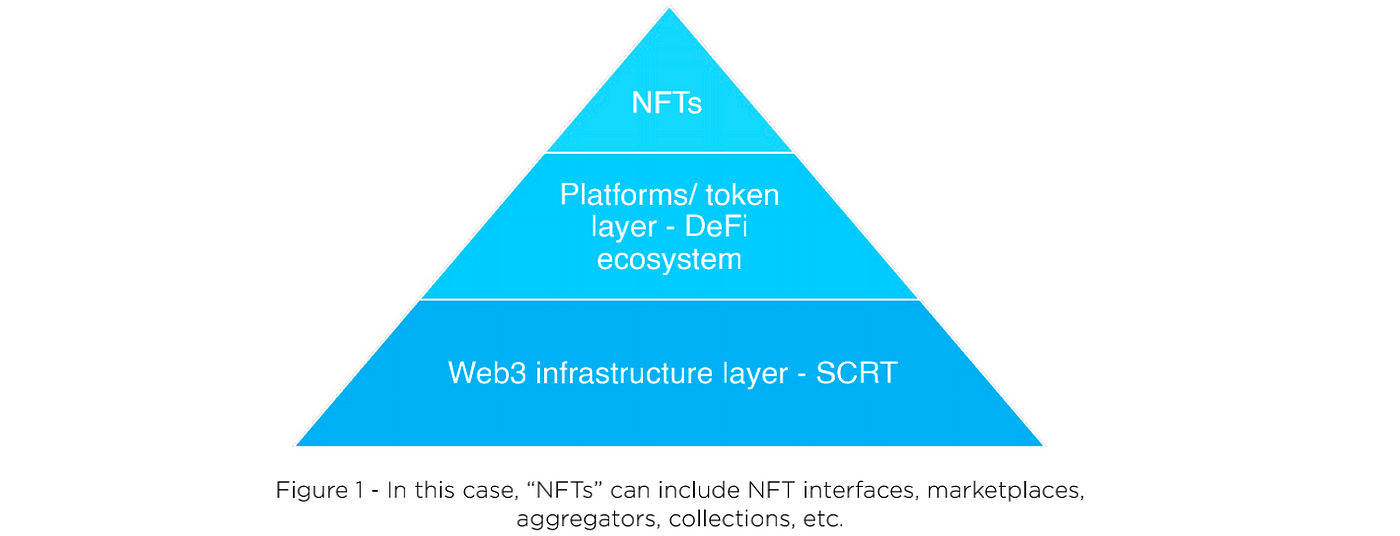
The market cap/TVL ratio is at 20, which is substantially high compared to other platforms. The high market cap/TVL may be due to the fact that people are optimistic regarding Secret’s growth and are pricing in the future growth. It may also mean that Secret is overpriced. However, to have a market cap/TVL lower than 1 at the current price, the TVL would have to grow to approx. $870M (from the current $47M), which compared to other platforms, is not far-fetched.
The fact Secret’s market cap/TVL ratio and TVL may also indicate the high potential for DeFi protocols on Secret — for example, SecretSwap (SEFI) and SiennaSwap (SIENNA) — that are still relatively small when compared to many other DeFi protocols and have a lot of room to grow. On DefiLlama, SecretSwap is ranked #320 per TVL, while Sienna TVL is around $10M.
Who are the users? Privacy benefits everyone. If you have a regular bank account, you want your balance, transactions, and salary to be kept private. If you own artworks, you may want them to keep private. If you have medical records, you probably want to keep them private. As a business, you may also want to keep some of your transactions private. The users are any person interested in keeping some degree of privacy.
Although there are other privacy coins such as ZCash and Monero, they fall short on handling smart contracts or DeFi applications. Other Ethereum apps like Tornado Cash can obfuscate the transaction flow, but it’s far from keeping assets private. Secret is the leading network solving this issue. Secret allows privacy-preserving smart contracts, extending privacy at the application layer.
On Secret, transactions are private, but a user can give access to the viewing key in order for another person to check/view the transactions. Only the user that has the viewing key (decrypting key) and the SGX enclave (inside a specific intel processor) have access to the data. No one, no 3rd parties can see the data, not even the people that run the validator nodes.
Social media and community
Twitter — 171,000 followers
Instagram — 3,430 followers
YouTube — 2,450 followers
Telegram — 18,400 followers
Discord — 34,000 followers
Secret’s milestones for 2022
Secret Network goals for 2022 according to Tor Bair and Guy (the founders):
• 100 projects building on the network
• 5–10 applications with +10 000 active users
• Onboard artists to Stashh NFT community including Quentin Tarantino’s NFTs
• More Metaverse use cases
• Launching a privacy stablecoin
• Launching a decentralized email service
According to an interview with the Secret founder Tor Bair, team doesn’t envision at the moment integrating other VMs as Cosmos/Secret by itself allows for high composability by leveraging Cosmos and the IBC ecosystem.
Secret bridging
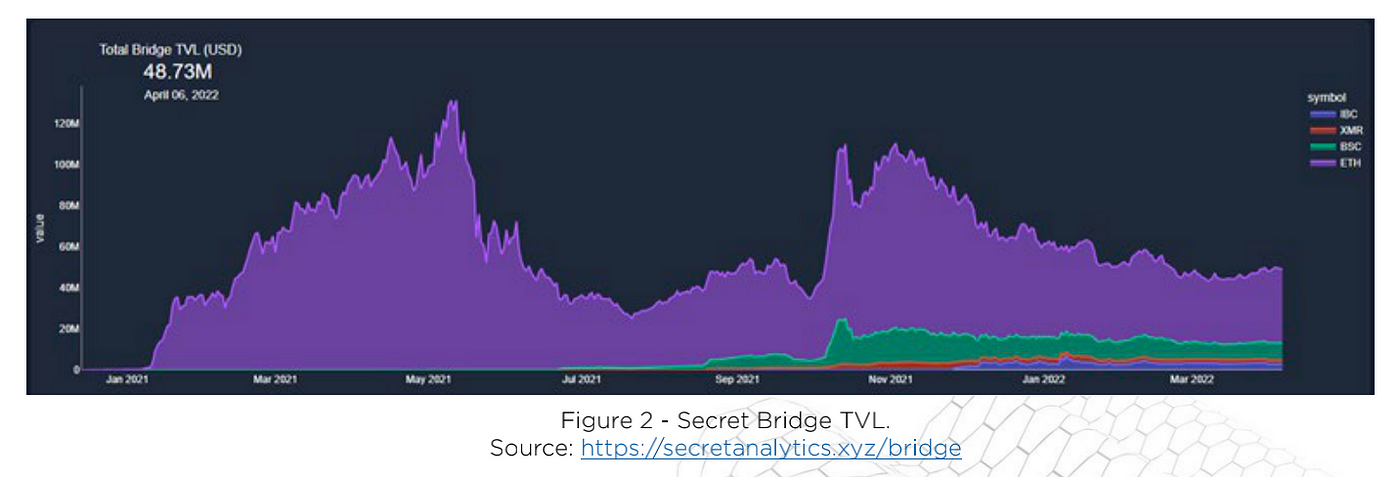
The Secret Bridge TVL bridges assets from other networks to the Secret Network. These assets are locked in smart contracts on the native blockchain and minted on Secret. The TLV comes mainly from the Ethereum bridge. It reached an all-time high in May 2021 with $130M TLV. The value of bridged assets dropped sharply to $25M. At the time of writing this report, the TVL sits at $48M. Not much, but it’s honest work!
The weight of BSC is growing in terms of TVL and now represents 17%. Ethereum still dominates, contributing to 71% of the bridged TVL.
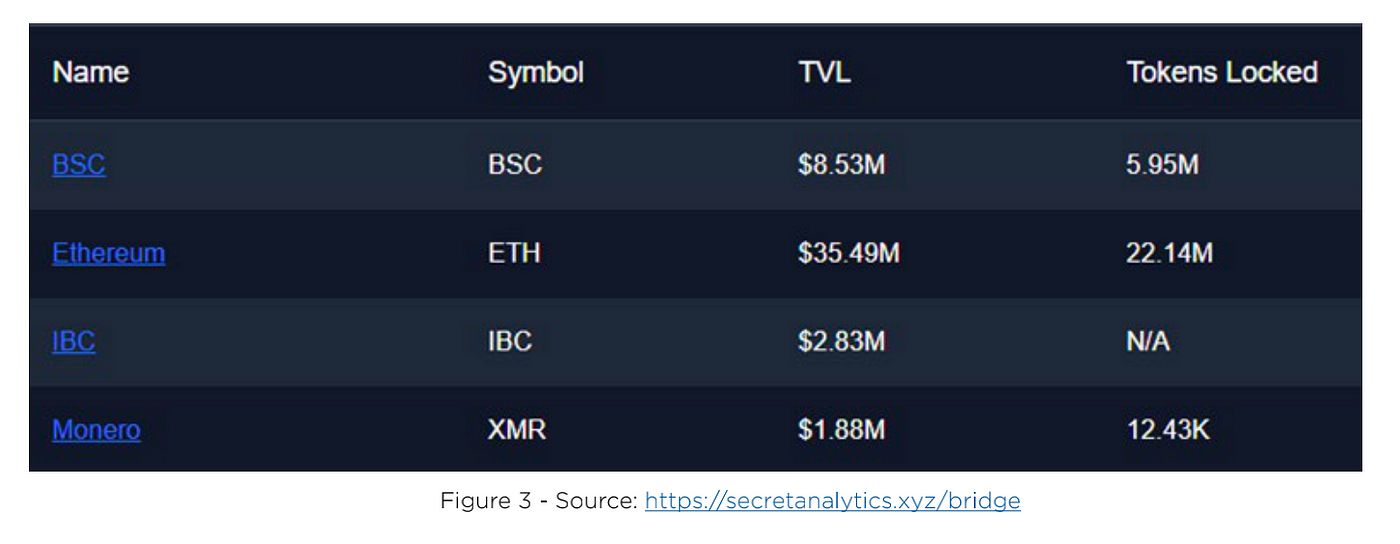
Use cases and ecosystem
Important to say that SCRT is not a privacy coin. However, Secret allows the creation of Secret tokens, for example, sSCRT, sETH, sUSDT, sWBTC and so on.
Secret allows the creation of secret smart contracts. Transactions done with secret contracts are hidden from everyone, including validator nodes on the network.
Most blockchains work with a key pair (the typical PKI — public key infrastructure that is used in asymmetric encryption and that typically people refer to as public key and private key). Secret has a third key on their toolkit: the viewing key that users can use to prove/show ownership of any assets in the Secret network. This is also good from the regulatory compliance perspective. If authorities require access to the data, the user can provide the viewing key.
By now, you can start imagining the potential benefits of having private fungible assets. Users can bridge, for example, their ETH, USDT, or SHIB to Secret, which will become sETH, sUSDT, or sSHIB, i.e. the Secret version of the token and thus creating a privacy layer for their tokens.
Non-fungible assets can also be made secret. The NFT industry can also benefit from Secret features, allowing the NFT owner to choose to make the NFT public or private. If I buy a Basquiat painting, I may want to be an anon buyer. In the same way, buying an NFT on the Secret network would allow users to be full anons unless they decide to reveal the ownership of the NFT.
Other use cases include whenever privacy is important for the users and regulated industries:
• Healthcare
• Data sharing
• DeFi
• Gaming
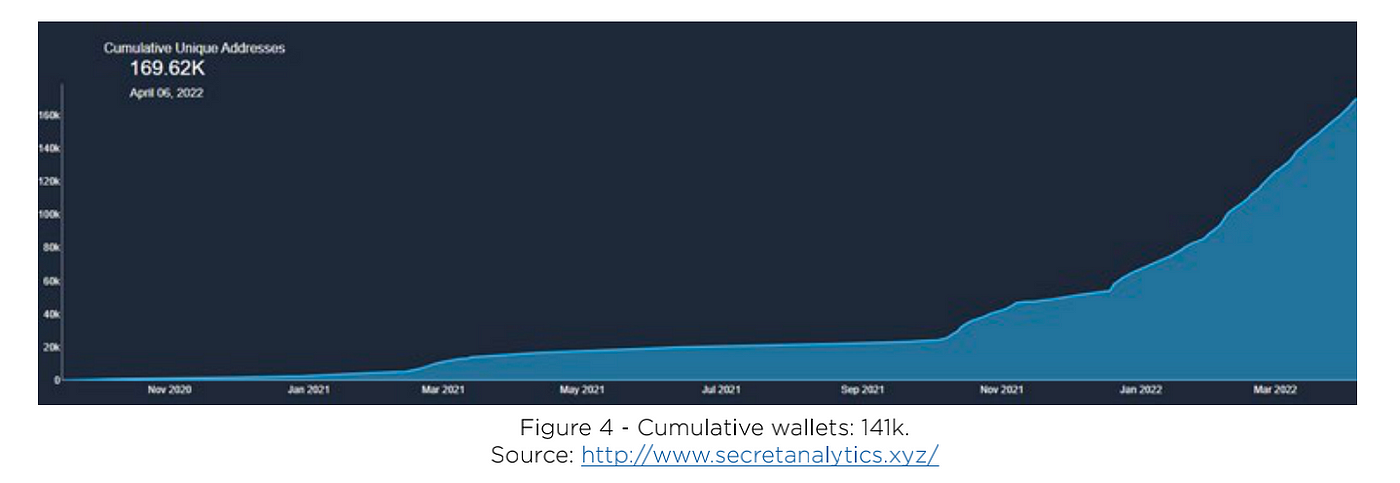
During Q1 2022 (i.e. until 14th March) the number of Secret addresses more than doubled. In fact, although the network was launched in March 2020, around 65% of all addresses were created over the first 3 months of 2022, which reveals a big adoption acceleration.
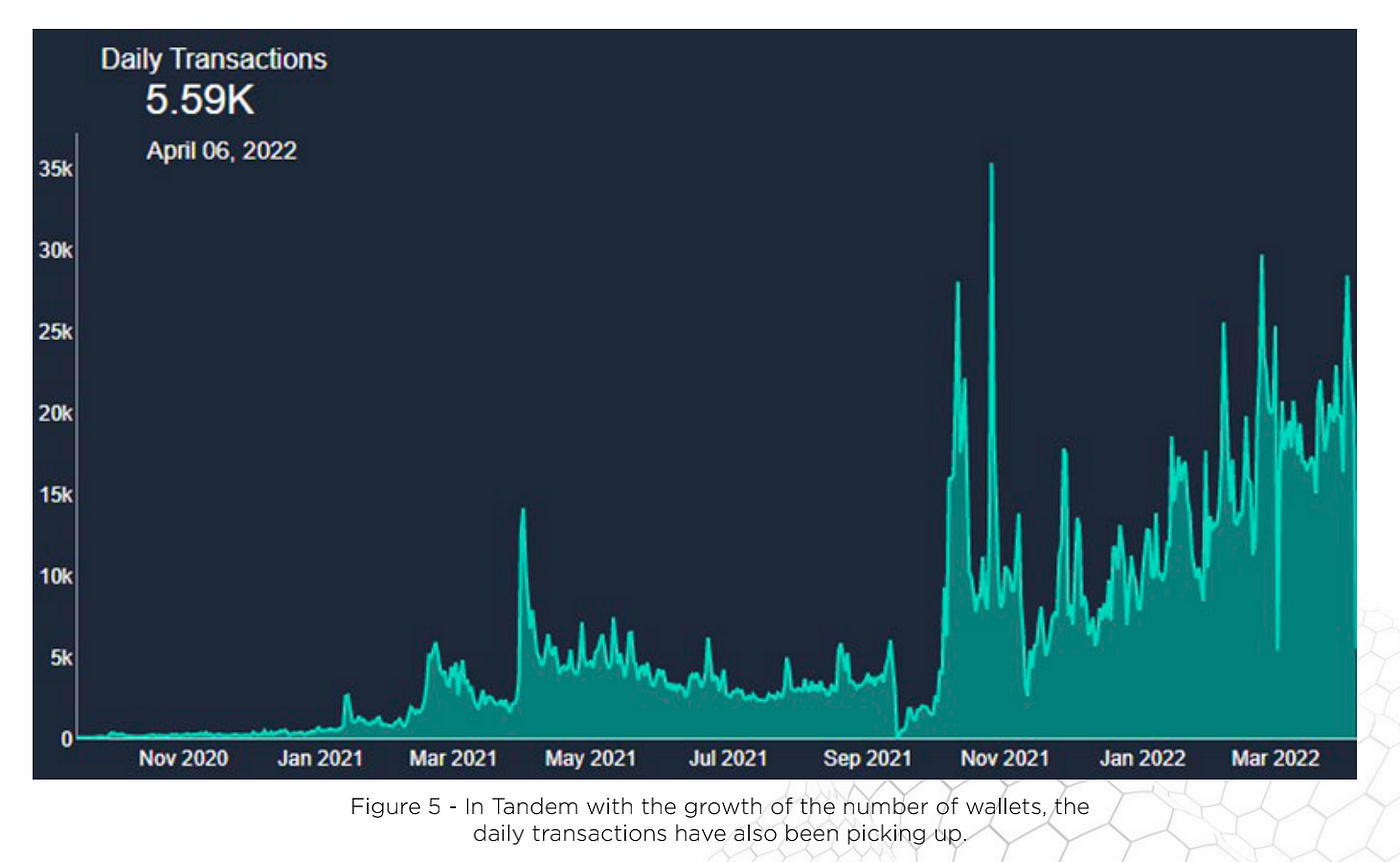
The number of unique addresses and daily transactions has increased substantially since 2021, which may create a snowball effect. At the same time, SCRT token price has been diverging from the network activity, which may be seen as a bullish sign.
The technology
Secret uses the Cosmos SDK and Tendermint consensus, which is also part of the Cosmos stack. Tendermint is a DPoS consensus mechanism, and the block time is 6.5 seconds. In theory, it can process up to 14 000 tps. However, the Intel SGX processor used by the validator nodes is a bit more limited in terms of speed. The Secret team is implementing multi-threading to increase the throughput. Optimizations can be done, but the team seems to be confident regarding the network’s scalability. On the other hand, the network scalability is also limited by the Secret Network block size, which at the moment is 10M gas but can be changed.
Currently, the maximum number of validators is 70 using Teadermint’s DPoS. The validators also need to stake a number of coins. If they fail to maintain a consistent and honest node, they will be slashed, and coins will be deducted from their account. Nodes can also be banned for double signing. Validators are also slashed for downtime. Network upgrades and security patches are easy to implement because of the small number of validators.
According to the CEO — Guy — Secret plans to grow the number of nodes over time, which is good from the decentralization perspective.
Anyone can be a validator (as long as you are voted for it), but most validators are running more serious infrastructure (servers, cloud infrastructure, etc.). Normal users don’t need to run any nodes. There’s no concept of full nodes or light clients.
What do validators do? Well, they keep the network’s consensus and execute transactions and Smart contracts. The smart contracts are executed in TEEs — Trusted Execution Environment, which allows executing/processing data while encrypted. This is achieved by using Intel SGX processors that leverage secure enclaves. These processors allow for processing encrypted data without the need to decrypt it.
Intel SGX is seen as very secure, and until now, there are no practical security vulnerabilities. However, there’s a big dependency of the Secret Network on Intel SGX processors, making Secret highly dependent on one single vendor. Certain questions like “what if one day a vulnerability on Intel SGX is discovered and exploited?” remain to be answered. Additionally, what happens if Intel stops supporting the SGX chips?
Bridging assets to Secret
To mint Secret tokens (for example, sETH) one needs to send ETH to a smart contract that will mint the sETH. This is possible using the Secret Bridge: https://bridge.scrt.network/
These tokens (for example, sETH) are Secret’s SNIP20 standard is similar to ERC20.
In terms of adoption, one of the key strategies for development has been connecting to other networks with an existing user base and liquidity. The Secret Bridge currently supports 3 networks: Ethereum, BSC, and Monero. Terra bridge was also recently updated with the Supernova upgrade (using IBC), which is a bullish sign considering its fast growth.
The bridge supports dozens of tokens from Ethereum and BSC. It connects with Metamask and Keplr wallet to bridge the assets from/to Ethereum/BSC to Secret (Cosmos Keplr wallet). The bridge is bi-directional, meaning that we can send Ethereum, Binance Coin, and many other tokens to the Secret Network, which is going to be connected to the Keplr wallet (or another Cosmos compatible wallet).
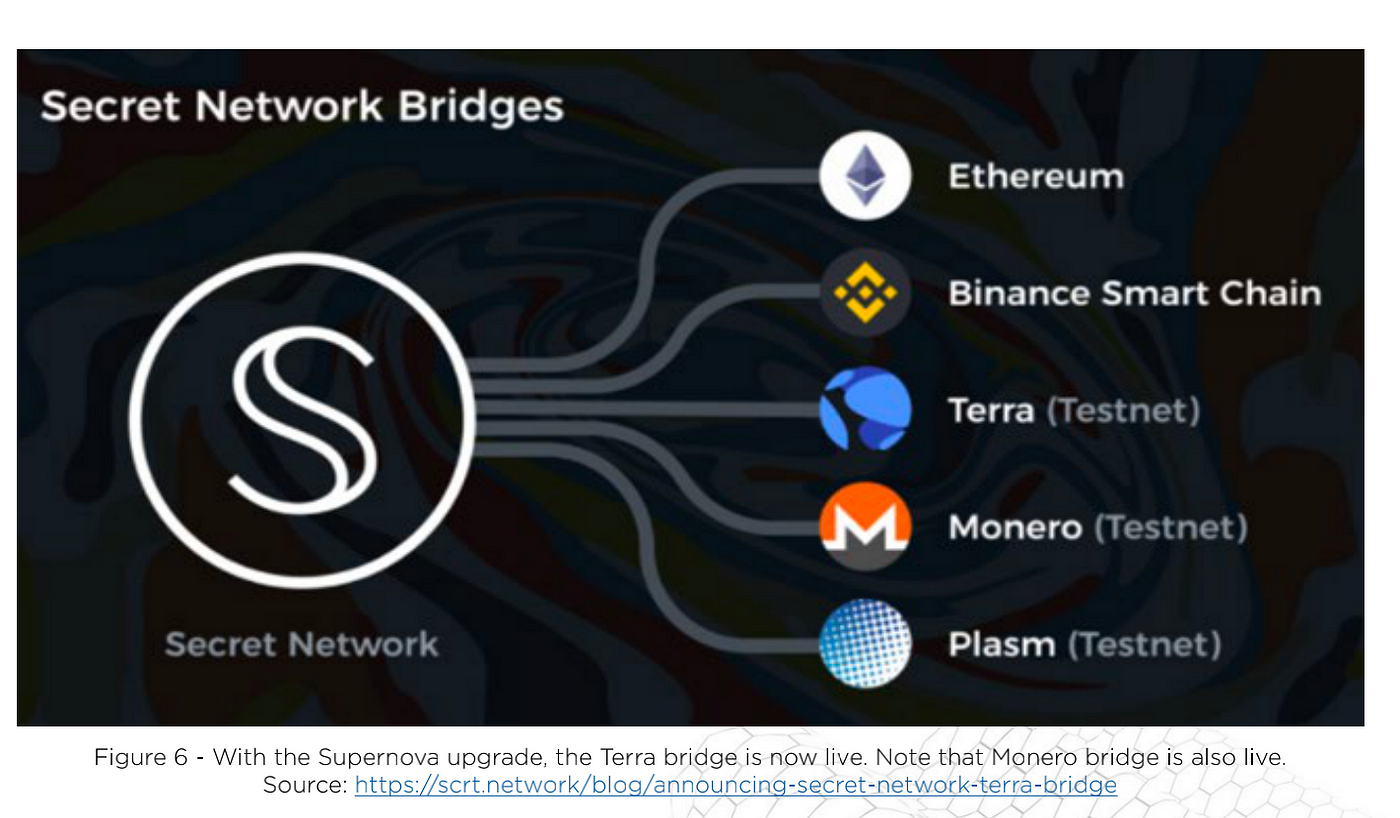
How does the bridging process works? First, the user sends ETH from Ethereum to Secret using the Secret bridge. The asset (ETH or an ERC20 token) will be locked in a smart contract on Ethereum and minted secretETH or sERC20, which are wrapped tokens on the Secret network, based on SNIP20. Users need to wait for 3 confirmations to see their assets on Secret. Then, to send the ETH or tokens from Secret back to Ethereum, the tokens are burned on Secret and released on Ethereum.
The gas fees to bridge to and from Ethereum are fairly high (because you still need to interact with Smart Contracts on the Ethereum blockchain), but the fees are low once the assets are on Secret. Secret’s interoperability leverages the Cosmos SDK, which allows developers to add plug-and-play modules, including the IBC — Inter-Blockchain Communication that allows networks to communicate with other IBC-enabled blockchains.
Secret allows sending native assets across IBC chains (inter-blockchain communication) — Cosmos, Ethereum, Polkadot, Avalanche, Fantom, and other chains.
Token economics
The Enigma tokens $ENG were replaced by $SCRT tokens in 2020.
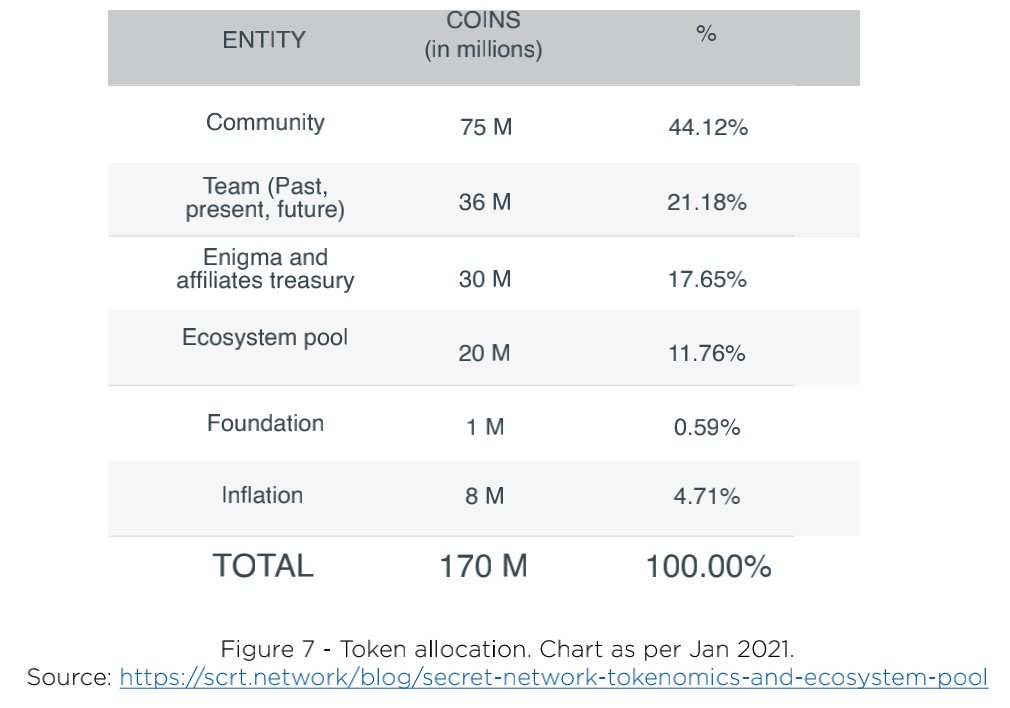
The grants program (ecosystem pool) has 20 Million SCRT, which is approximately $100M as of March 2022. On top of that, the ecosystem fund received additional $400M from HashKey, DeFiance Capital, Alameda Research, and CoinFund. In fact, the ecosystem fund has at the moment over 25 contributors.These grants will help to build applications on the network.
$SCRT token is also used as a governance token to vote for community proposals. Proposals can be seen here.
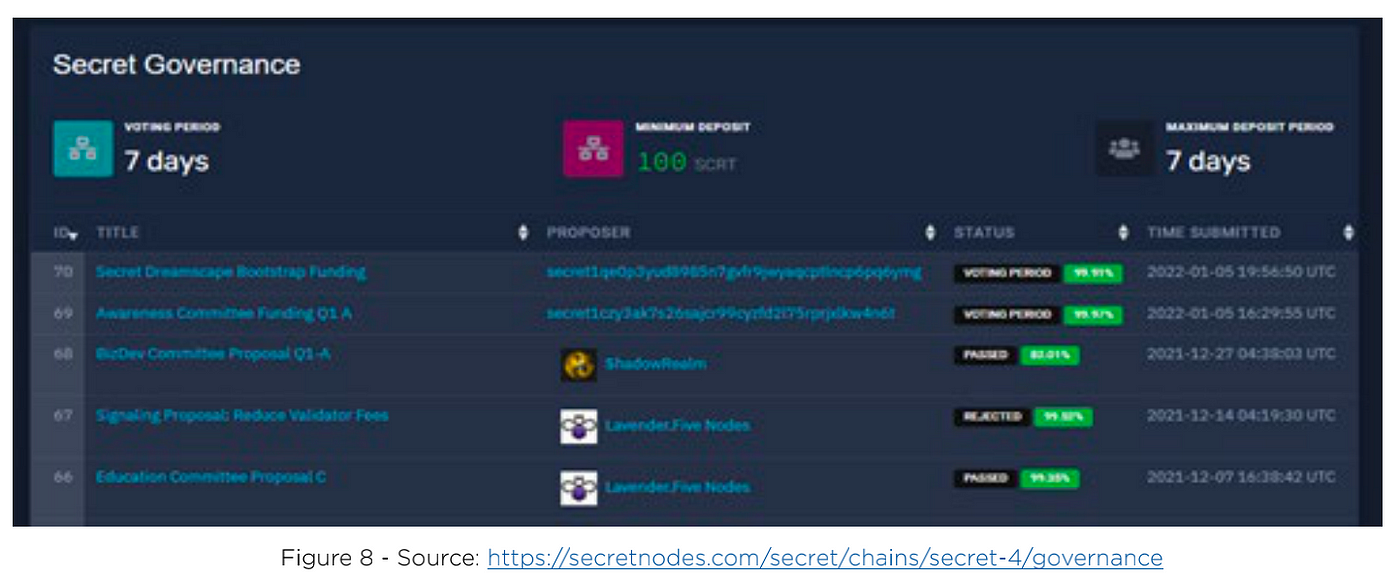
The project can also mint new coins to fund the development with voting approval. The Secret foundation receives 15% of all staking rewards as a foundation tax to support the development of the network.
Current token supply: 163 B $SCRT
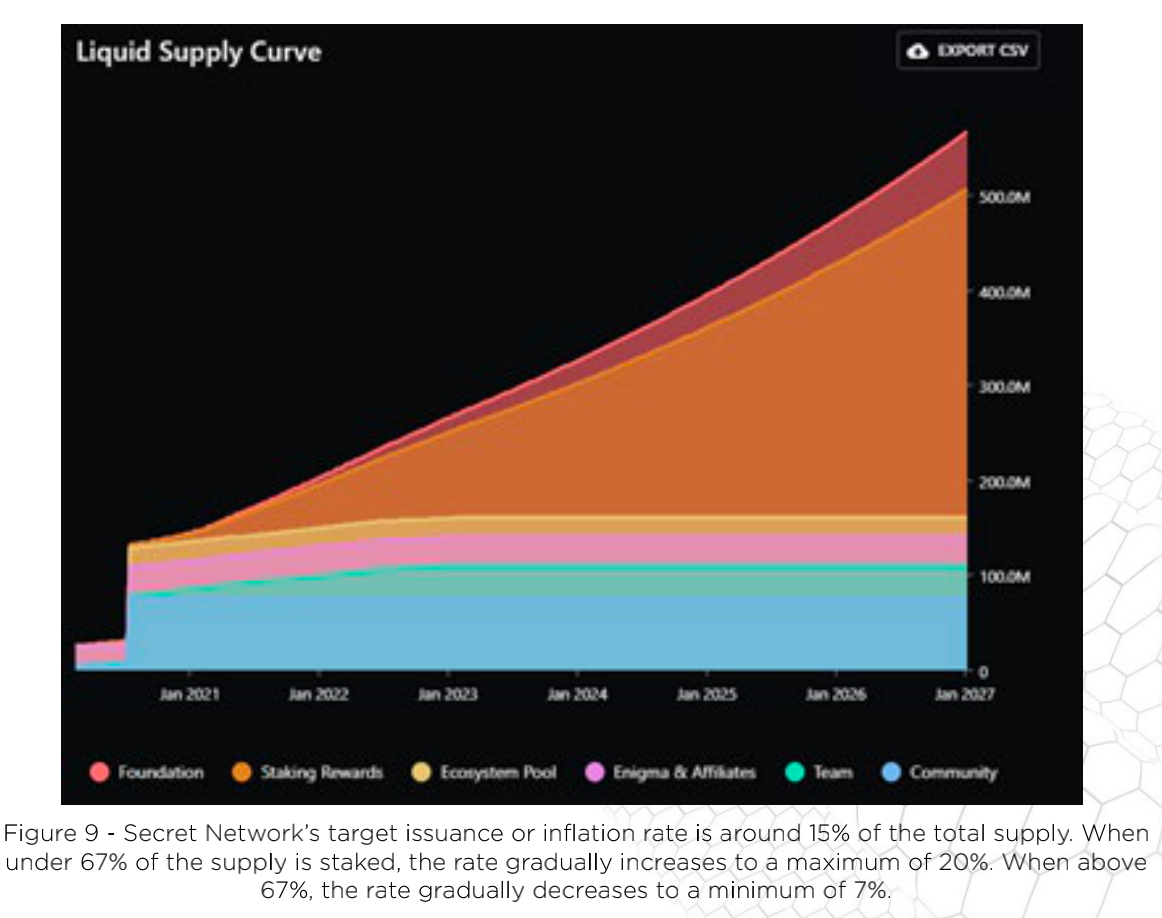
Is SCRT inflationary? The average inflation rate is 15% (used to reward validators and delegates) at a rate close to 25%. This means that hodlers can easily offset the inflation effect by staking their SCRT.

So, as we have seen, the number of stakers is increasing (which removes tokens from the circulating supply), the number of wallets has been increasing and the developer activity is also increasing.
Governance
A portion of the tokens is allocated to initiatives related to the Secret Network committees. They aim to promote Secret and incentivize adoption and global growth. There are 9 committees.

The Awareness Committee seems to be one of the most important for Secret. They actively execute the marketing plan and do the “Secret Agent” recruitment. They do developer’s advocate work and earn 2% of all staking rewards as an incentive.
Secret uses an on-chain governance system that derives from Cosmos. Users can submit proposals, vote, and have an active role on governance. To avoid spam, it is necessary to deposit 1000 SCRT in order to create a new proposal.
Secret DeFi Ecosystem
There are 3 DEXs on Secret: SecretSwap (SEFI), SiennaSwap (SIENNA) and btn.group (BUTT).
Although technologically sound, these DEXs have a microscopic size when compared for example to Osmosis (one of the biggest DeFi protocol on Cosmos). Osmosis TVL is at the time of this writing $1.6B. For comparison, SecretSwap TVL is approx. $37M, Sienna sits at $11M and the youngest DeFi protocol, the btn.group has only $1.2M in TVL. Considering their size, this may imply that the Secret DeFi protocols may have a huge upside although young and inherently risky.
In addition, there’s also the Secret Bridge to bridge asset and there’s one major NFT marketplace: Stashh.
Another important advantage of Secret is that Secret DEXs are front-running resistant. Front running is eliminated because transactions are private. Front running is a big problem in traditional markets and AMMs. Front running happens because the bad actor can see the incoming transactions and sandwich that transaction in order to increase its price against the trader. Privacy can solve this issue by making the pool of incoming transactions private. According to Secret’s website: “In other words, we have an encrypted mempool. This prevents malicious actors from gaining unfair advantages over honest users by watching the mempool. Therefore, Secret Network is in a great position to create a fairer DeFi ecosystem.”
Another advantage is that Secret minimizes MEV — Miner Extractable Value — by preventing the validators from seeing transaction data and reordering transactions for their benefit.
NFTs on Secret
NFT owners can decide if they want to show their NFTs or not. There are multiple possibilities for NFTs.
NFTs on Secret use the Secret NFT standard — SNIP-721. The NFT ecosystem can largely benefit from Secret advantages. Ethereum’s high transaction fees, low throughput, and lack of privacy allow Secret to stand out by providing low transaction fees, faster throughput, and privacy features.
NFTs can have additional features such as “the ability to (1) hide ownership of scarce items, (2) privatize the metadata field (how an NFT signature connects to off-chain data like art), and (3) control access to the connected content.”
Additional DeFi ecosystem development
A privacy-preserving stablecoin is also coming soon to the network. This stablecoin — Silk — is backed by a basket of assets and it’s built on the top of the Shade protocol. The Silk stablecoin will inherit the privacy features from Secret and it will be interoperable with Osmosis, Juno and the Cosmos ecosystem.
Secret provides grants to incentivize application development. The grants come from the $400M ecosystem Fund and this is made with the mentorship from Secret Labs. The grant application and approved grants can be seen here. If you would like to build on Secret but you don’t have a use case yet, make sure you check this list of ideas.
Secret Network Challenges
- Secret still need to bring critical mass to the network in order to bring network effects
- Bring more developers and dApps onboard
- Draw more attention from the crypto community
- Although growing, the NFT ecosystem is still small. Secret needs to make a better work spreading the word to artists and NFT community
- Dependency on Intel SGX processors
Oasis Network
Overview
Just like Secret, Oasis Network goal is to be a privacy-enabled blockchain. The Oasis Network was founded in 2018 out of Berkley, University of California, by the hands of professor Dawn Song. In fact, Oasis continues to have strong ties to the academic community, having the largest University Program among all the L1 blockchains, including over 25 universities in the program (including for example top universities like Berkley and Tsinghua). The Oasis University Programs seems to be one of the biggest sources of research and new projects that come from university hackathons.
The public testnet was launched in Nov. 2019 and the beta mainnet was launched in Oct. 2020. The production mainnet was launched one month after, in Nov. 2020. Although the production main net is live, the privacy features are not enabled yet.
So what is Oasis? Oasis is a privacy-focused Layer-1 smart contract blockchain network that uses the Cosmos SDK. Oasis achieves data-privacy and confidentiality by separating the consensus layer from the smart contract execution layer. The biggest advantage of Oasis is that it is a fully modular blockchain network that has at its core the consensus layer and it may have several paratime chains that communicate with the consensus layer.
Version:0.9 StartHTML:0000000105 EndHTML:0000000323 StartFragment:0000000141 EndFragment:0000000283
The technology
Oasis uses the proof-of-stake Tendermint consensus mechanism and it has 110 active validators that are elected via delegation. In this aspect, Oasis is pretty similar to Secret, just with a higher number of nodes.
The main difference between Oasis and other chains is that Oasis separates the consensus and execution into 2 layers, which theoretically provides better transaction speed and scalability. This allows multiple paratimes to process transactions in parallel, allowing for more efficient resource allocation, especially in regards to more complex workloads. These paratimes have their own segregated nodes and nodes may have different requirements for each paratime. For instance, the Cipher paratime uses TEE — Trusted Execution Environments that run on Intel SGX. This means that Cypher paratime is segregated and uses a separate set of nodes with TEE capabilities.
It’s important to note however that the Cypher paratime (i.e. Oasis privacy layer) is still in testing phase and not live yet. According to the Oasis moderators, the privacy layer will be available during H1 2022.
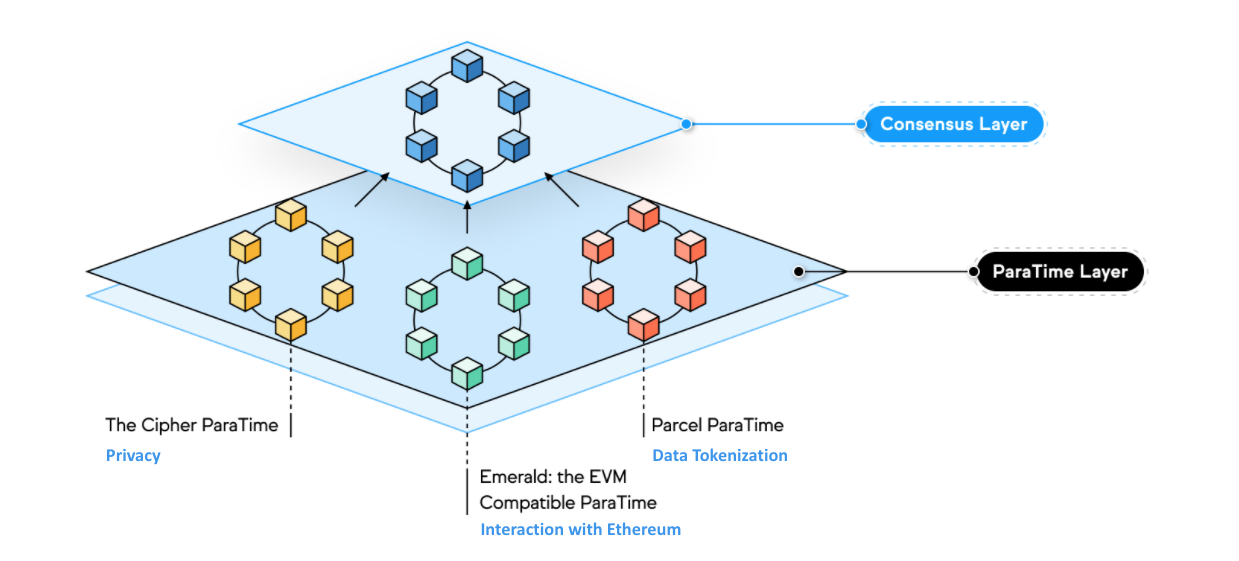
EVM compatibility: one of the biggest Oasis perks is the Emerald paratime. The Emerald paratime is the Oasis environment that is EVM compatible. It basically allows to deploy an EVM smart contract, including ERC20, ERC721 and 1155. This is great news for solidity developers that wish to leverage the easy portability and bring their Ethereum dApps to Oasis and to the Cosmos ecosystem. In the futures, these EVM dApps could also benefit of the data tokenization and privacy layers.
Emerald can currently handle 1000 tps and according to the Oasis Foundation block explorer, it was handling around 200 000 transactions per day in February 2022. Then, in early March, the number of transactions spiked to over 2 million per day, which is a weird number considering the real activity going on the network and the fact that this can clog the EVM transactions.
Talking about throughput, each Oasis paratime can handle up to 1000tps but considering that Oasis can handle multiple paratimes, the throughput can in theory scale up to hundreds of thousands transactions per second just by deploying additional paratimes.
Paratimes are quite versatile. Users (for example institutional users) can create their own customizable paratimes (emerald for EVM, Cypher for privacy or Parcel for data tokenization). Rust is the main language but the Emerald paratime also handles Solidiity.
This customization is a great invitation for organizations to use and transact on Oasis, considering that they can segregate their nodes and keep the data private, while benefiting from the Oasis network and consensus layer.
Oasis is part of the Cosmos ecosystem but it doesn’t support IBC — the Inter Blockchain Communication yet. According to the roadmap, the IBC support should have arrived Q3/Q4 2021 and it should become fully implemented during the first half of 2022 (not too far away; I guess good things take time). The IBC would be great news for ROSE (the Oasis native token) considering that it will allow interoperability between Oasis and the other IBC networks (Osmosis, Cosmos, Juno, Terra and of course, Secret). Considering that Osmosis is the biggest DeFi platform on Cosmos ($1.81B TVL), bringing ROSE to Osmosis pools could be a very good additional source of demand for the token and drive some positive price action.
One of the most recent achievements of the Oasis was the Wormhole portal integration that allows bridging assets from/to Ethereum, Polygon, Solana, Avalanche, BSC, Terra and Oasis.
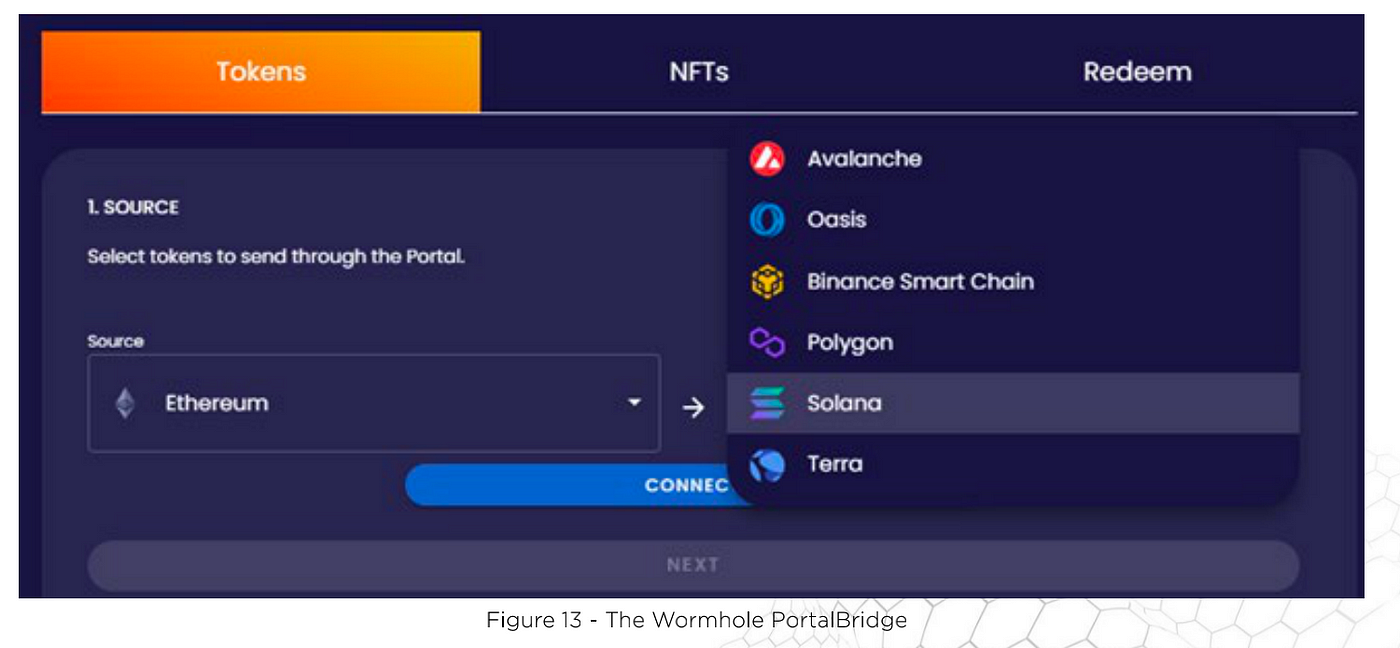
Social media and community
Twitter — 158,000 followers
Instagram — 6,400 followers
YouTube — 4,800 followers
Telegram — 58,300 followers
Discord — 11,800 followers
Social media and community
The Oasis roadmap has a number of upgrades and milestones but the ones below seem to be the most relevant in terms of bringing a positive impact to the network.
- IBC planned for H1 2022
- Cypher paratime (privacy layer) is planned to go live H1 2022
- Partnership with Meta also planned for 2022
Use cases, ecosystem and developer ecosystem
Oasis allows the creation of smart contracts developed on Rust or Solidity using the Emerald paratime. However, the EVM side of Oasis will not be compatible with the Cypher paratime (the privacy layer), meaning that EVM assets — for example ERC20 tokens bridged to Oasis via Emerald, would have to be bridged again to Cypher in order to gain the privacy layer. This adds complexity to dApps trying to develop on Oasis.
Oasis privacy-preserving layer comes with the Cypher paratime smart contracts, which can be seen as almost a segregated chain inside the Oasis network. The Cypher nodes will run on Intel SGX. This will be positive not only for the confidentiality of transactions but also to stop DEX front-running, to allow users to keep their assets and NFTs private, and allow sharing data with CeFi in order to unlock the undercollateralized loan market.
Finally, the Parcel paratime can tokenize data in a private manner which is great for existing use cases such as Nebula Genomics, Genetica, and BMW. This data tokenization can potentially unlock a vast data market where people can be rewarded for sharing their data without having to reveal their identities (for example, sharing genomics data or driving behavior).
In fact, according to this Oasis post, BMW has tested the privacy capabilities of the network, aiming to increase data security and compliance with data regulations such as GDPR and CCPA. Oasis data tokenization institutions to access to some of the data without relating it to the user/ provider of that data, which potentially unlocks many use cases.
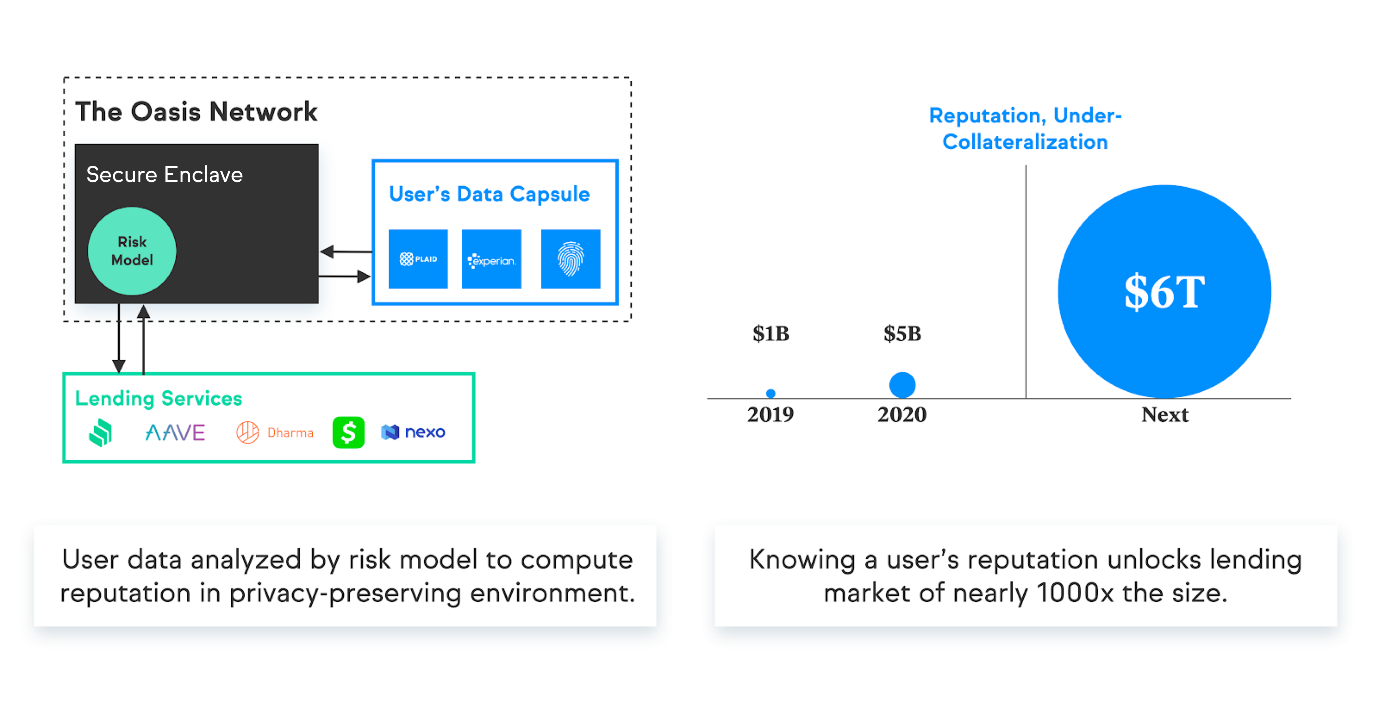
The image above shows data being shared from the user’s data capsule (using Oasis Parcel and Cypher) to DeFi lending platforms. The data sharing keeps the user’s identity private, while allowing at the same time the DeFi lending platforms to look at other data points that will allow to access the credit risk, thus enabling better DeFi risk management and undercollateralized loans which when compared to the current overcollateralized model, could unlock billions of dollars in the lending market.

Data tokenization is already unlocking use cases where users can “stake” their data through the Oasis network and the data can be used by data consumers (social media apps, trading apps, healthcare, etc.). Users can in theory be rewarded for “staking” or lending their data. The model sounds very promising by flipping the ownership of personal data to the user rather than the company the user interacts with. However the model still needs to be proven to work at scale.
Token economics
The $ROSE token was launched in Nov. 2020 with 1.5 billion tokens supply, and the supply is caped at 10 billion. As of March 6, 2022, the circulating supply is 3.5 billion $ROSE, representing only 35% of the total.
The ROSE token is used for staking, delegation and transaction fees.
The tokens will be released according to a vesting schedule that is divided between staking rewards, ecosystem, partnerships, backers, contributors and the staking. It will take around 12 years to be close to the 10 billion $ROSE issuance.
The biggest cliffs/token releases happen at T+12 and T+18, which counting from the launch of the mainnet in 18th Nov. 2020, correspond to 18th Nov. 2021 and 18th May 2022.
Each of these 2 big unlocks is unlocking approx.. 1.4 Billion tokens which would in theory represent a big selling pressure. However, although the Nov. 2021 release represented additional 66% token supply in the market, the price impact was minimal. The price declined by 12% on Nov. 18th but re-bounced right after that, going from $0.268 to $0.416 on Nov 21st — a 55% jump.
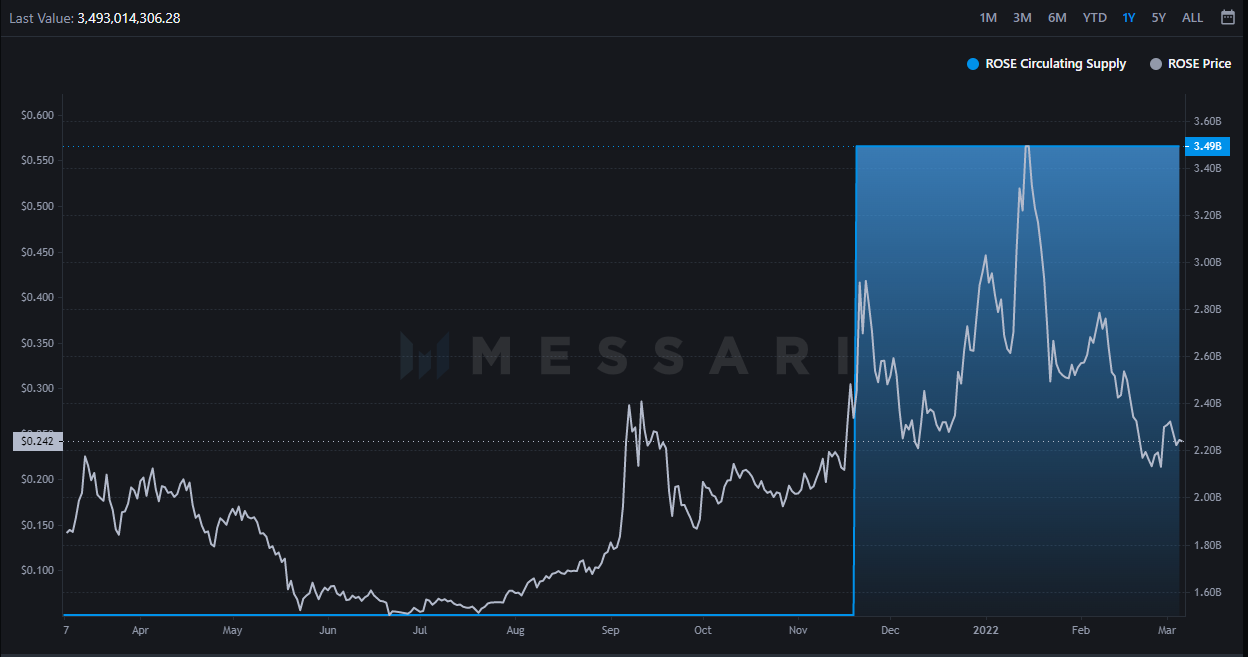
The minimal price impact of the increased supply may be partially explained by the fact that a good part of the tokens was released to the “Community & Ecosystem” slice of the pie, which aims to foster the development of the apps and provide developer grants and community incentives. Consequently, these tokens will be slowly distributed, mostly to new projects or community initiatives, rather than suddenly dumped in the market.
The May 18th 2022 release will also see 1.4 Billion tokens arriving to the market, which will represent another big circulating supply increase, this time approx.. 40%. We are curious to see how is this going to impact the market. Perhaps a good opportunity to buy?

After May 2022 and until Nov. 2024, $ROSE circulating supply will increase by 0.8B ROSE per year, and then it will reduce to 0.2B new $ROSE every year until 2031.
Staking ROSE allows users to earn up to 12% APY (for validator nodes) or 10.21% for delegating ROSE.

By the way, if you see a better APY on some exchanges like Binance and start to ask yourself why stake on Oasis if Binance pays more than double the APY? Well, the simple answer is that the Binance staking has a very limited quota. In this case, the limit to get the 27% APY is merely 500 ROSE tokens (i.e. approx. $100).

The Oasis staking (both delegating or running a node) has been showing a very healthy increase, gaining 18.4% stakers over the last month. The taking participation was at the time of this writing at approx. 54%.

The Oasis staking (both delegating or running a node) has been showing a very healthy increase, gaining 13.8% staking participation over the last month, taking the staking participation to 54.3%.
Governance
Inspired by the Meritocratic Governance Model used by The Apache Software Foundation, Oasis uses a democratic, consensus-based and community led governance model which works mostly off-chain.
Anyone interested in supporting the network can join the community and contribute with proposals that can go from feature requests to bug fixes. The proposals are submitted and recorded on GitHub.
The proposal discussion and voting is done off-chain but the Oasis Foundation plan to migrate the process to an on-chain process.
DeFi Ecosystem
With a TVL of $148M, the Oasis TVL comes mainly from ValleySwap and Yuzu Swap, both Decentralized Exchanges on the Emerald paratime. The bridging between other networks and Oasis can be done via Wormhole Portal.

Developers looking to develop dApps on Oasis can leverage the Oasis Community Garden which has some useful resources from how to run a node, how to apply for grants, knowledgebase, official wallet and so on.
Although the Oasis ecosystem page reports more projects, according to Defillama there are 10 active DeFi platforms on Oasis. Together, they sum $162M in TVL as off 8th March.
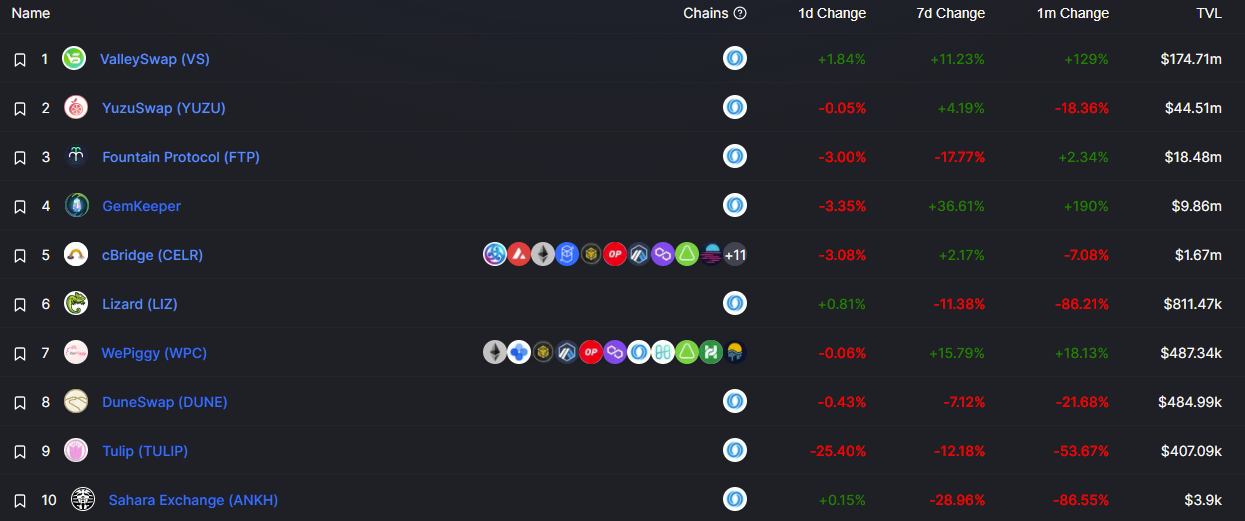
The Oasis ecosystem seems to be blooming with multiple applications on lending, DEX, DAOs and upcoming NFT collections. This is probably due to allocations related to the Ecosystem Fund and it may be a good driver for the ROSE price in the near future.
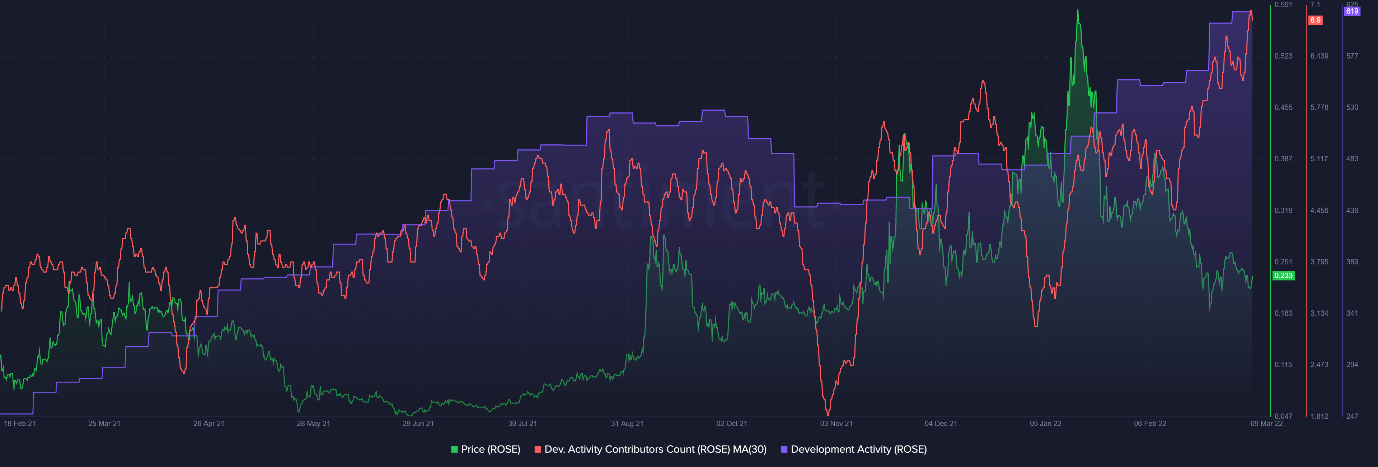
The Oasis developer activity has been increasing and diverging from the ROSE price. This may be a bullish sign considering that the developers continue betting on building applications and improving Oasis. Developer activity is usually a lagging indicator but in this case, we can see that Oasis developers (including the ones developing applications in the ecosystem) continue to bet on the network.
What are other applications launching on Oasis? A good chunk of the applications being launched on Oasis are beneficiaries from the Oasis Foundation Ecosystem grants (the $200 Million fund). These applications also contribute to the developer activity that we see above. This is probably also the explanation why many of the applications listed on Oasis website are shown as “coming soon”.
Currently, there are 6 DEX, 1 bridge and 2 lending protocols (although we could only see one working). Note that half of the DEXes have low liquidity and TVLs under 4M.
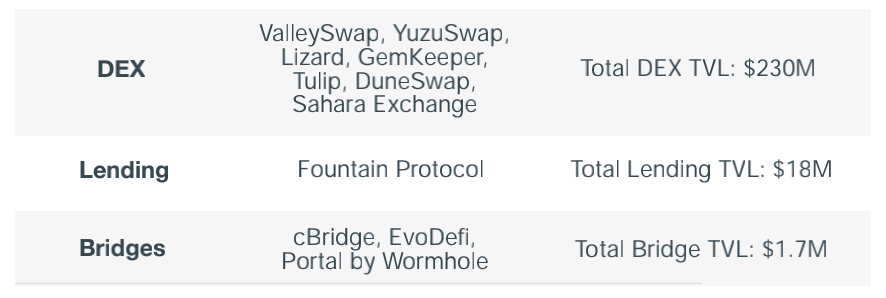
Regarding the NFT market the NFT activity comes mainly from the tofuNFT platform which is a NFT marketplace/ aggregator for a number of networks, including Oasis and other 24 blockchain networks. There’s also some residual NFT activity coming from MetaMirror, mainly due to the AI Rose collection.
What kind of NFT collections can you find on Oasis? Well, as in many other chains, you will find knock-off collections like Oasis Apes, Oasis Punks and Oasis Doodles. You will also find some original collections like Dope Wolves (they are indeed dope), Pixel Oasis and the TWCC collection.
The Ecosystem Fund
In January 2022, the Oasis Foundation announced that the Ecosystem fund has a total of $200 Million from contributors such as Binance Labs and other big names such as Dragonfly Capital, Draper Dragon, Electric Capital, FBG, Hashed, Jump Capital, Kenetic Capital and Pantera. The goal of the ecosystem fund is similar to other ecosystem funds: to empower and support applications, including DeFi, NFTs, Metaverse, and other dApps to develop on the Oasis Ecosystem. During the first 2 months of the Ecosystem fund has distributed over $2.5 Million. Probably this is one of the reasons why we can see the developer activity increasing on Oasis.
Part of the ecosystem fund comes from large backers and investors: Oasis has a long role of key investors that include names like Arrington Capital, Binance Labs, Bitmain, Blockchain Capital, Electric Capital, Pantera, Polychain, Winklevoss Capital and A16Z.
Finally, another driver for engaging with the community is the ambassador program where Oasis enthusiasts can apply to join the program and be rewarded for completing tasks related community building, developers advocacy, social media activity and so on.
Oasis Network Challenges
- The Cypher paratime (privacy layer) is not yet deployed at the time of writing this report. It will have to prove itself and be hardened by real network activity
- The Emerald paratime still suffers from transaction flooding (almost at DDoS attack level) by arbitrage spamming bots. This may sometimes slow down user’s transaction speed
- Bring more developers and dApps onboard
- Draw more attention from the crypto community
- Although growing, the NFT ecosystem is still small
- The Cypher paratime may be dependent on Intel SGX processors
- Better developer support may also be needed
Horizen Network
Overview
Let’s start with a cool fact that maybe you didn’t know (at least I didn’t know it before start researching Horizen) — Horizen is the top blockchain in terms of node count: it has the largest node network with approx. 44,700 nodes (although some are hosted by cloud providers). Bitcoin is considered a good example of decentralization but it has “only” 15700 nodes. I guess we can say that Horizen has a truly decentralized network.
Horizen uses a cross-chain protocol called Zendoo. This protocol allows developers to build highly modular blockchains and applications, with a better degree of flexibility even when compared to Cosmos or Polkadot.
The network uses a robust Proof of Work consensus mechanism, it leverages zero-knowledge proofs (zk-SNARK) for privacy-preserving transactions and uses SDKs for highly modular design and development. Developers can also develop their own chains on the top of Horizen in a very customizable fashion.
You can see Horizen as a public blockchain with a large node network and on top of it, developers can build any number of customizable side-chains. This is where they can enable the privacy layer. How does this help scalability and privacy? By allowing developers to develop their own Horizen sidechains — which anyone can do by using the Zendoo SDK — developers can build their tailor-made sidechains that can be public or private, have a customizable consensus and, depending on the dApp, a separate crypto-economy.
Zendoo is at the core of this Horizon ecosystem and scalability. The SDK is zk-SNARK enabled which brings the privacy layer to the Horizen dApps, whenever developers decide that they need to use that privacy layer. Zk-SNARKs also allows cross-chain verifiable transactions without the need for third-party validators. This means that the Horizen mainchain can verify/audit transactions and keep the consensus of any number of transactions happening in any Zendoo-enabled sidechains in almost real-time.
The side-chain SDK is available for anyone and it allows developers to customize their new sidechains, enable Cross-Chain Transfer Protocol (CCTP) if they want to talk with other Horizen chains, the privacy with zk-SNARK, proof of stake consensus (although Horizen main chain is proof of work, sidechains can be proof of stake), different kinds of transactions, wallets, etc. According to Horizen this sidechain SDK — Blaze — can handle up to 10M TPS (yes, I mean 10 million; that’s on Horizen’s website); how was it tested to handle 10M transactions I don’t know but if accurate, it could even handle data warehousing, AI, data analytics and potentially large volumes of IOT devices, which is a missing piece in the blockchain industry. The team is also building Latus which will allow for a higher decentralization and up to 20k TPS.
Horizen team has according to social media approx. 40 employees and in addition also relies on IOHK (Charles Hoskinson’s company also responsible for Cardano development) for research and development (among other tier 1 partners). In fact, Charles Hoskinson, Cardano’s founder, and Ethereum co-founder was also involved in the Horizen development.
Finally, kudus to the Horizen team for having such a well-organized website, documentation and helpful community.
Social media and community
The Horizen community seems to be fairly active and solid. The platform incentivizes the community to continue contributing to the ecosystem and continue building on the top of Horizen.
Twitter — 137,000 followers
Instagram — 11,900 followers
Medium — 15,300 followers
YouTube — 25,500 followers
Telegram — 4,840 followers
Discord — 8,000 followers
Milestones for 2022
Horizen seems to consistently execute the roadmap according to the plan, which is infrequent in the crypto space. Among other milestones, Horizen plans to:
- Implement EVM compatibility
- Launch a multi-token wallet
- Launch DeFi apps on EVM sidechains (this will probably unlock the DeFi ecosystem on Horizen which at the moment is almost inexistent)
- Although not part of the Horizen roadmap, I’m personally looking for other bullish news considering the community involved: the integration with the BAYC fungible token. A question that is still remaining is: if and how can this token exist in parallel with the Ape Coin.
Right after @Boredapyc community announced the partnership with Horizen, it was also announced that Horizen purchased the Bored Ape #6709 for ETH100 (approx. $420 000).

Network Metrics
The 44 700 nodes are divided into 3 kinds of nodes: the regular nodes, secure nodes and super nodes. Users can either setup their own node according to the requirements or rely on one of the providers that sell the “node as a service” service.
Rewards for running a node are attractive considering the fairly low cost of running these nodes when comparing to the rewards. A super node, for example, costs around $10 per month (using one of the “node-as-a-service” providers, while the rewards (block rewards) can be up to $100 per month. It takes 500 ZEN to stake and participate, which as off March 2021 would be approx. $21 000. This would represent a 5% APY on the staked ZEN. Not too shabby.
A secure node on the other hand costs approx. $3 and rewards $11 per month considering current ZEN prices. It requires the user to stake 42 ZEN (approx. $1800) and the APY over that staking would be 7.5%. Side note, there’s no traditional staking (like Secret and Oasis) on Horizen. To “stake” stakeholders need to run a securenode or a supernode and receive a reward for doing so. Securenodes require a collateral of 42 ZEN, and supernodes 500 ZEN respectively.
Use cases, ecosystem and developer ecosystem
If blockchains like Ethereum and Solana are an army knife, Horizen is a blank canvas where developers can build anything. What about Polkadot and Cosmos? Well, they allow for better flexibility for developers to build their own chains — the previous 2 networks in this report — Secret and Oasis are built on Cosmos. However, they are tied to the same consensus mechanism, and on Polkadot case, the 100 paratimes have to rely on just 300 validators.
Horizen on the other hand has a very flexible architecture and consequently, it can handle multiple use cases.
Some examples of the existing use cases (some of them leveraging the privacy features) include DeFi applications, CeFi entities and other blockchain networks. Some examples include Celsius which uses Horizen’s ZK audit for DeFi. Dash partnered with Horizen to “develop a fully decentralized, data protection solution using zero-knowledge proofs that anyone can use to build their own independent reward marketing programs.” The Morpheus Network leverages Horizen’s Zendoo for its supply-chain platform, and the IOTA collaboration allowing connecting IOTA oracles with Zendoo.
The developer ecosystem has been showing an uptrend pretty much since April 2019. Usually, developer activity is a lagging indicator. First we see the price going up and then we see new developers coming to the network. However, in this case, we see the opposite: the developer activity keeps increasing despite the price decline. This may be a positive sign for the network adoption.
Token economics
ZEN has a well thought and interesting token economics. Unlike many other protocols, there was no pre-mining, or ICO. Horizen was a chain forked from another network called Zclassic at block 110,000.
Similarly to Bitcoin, total number of coins to be minted is 21,000,000. The blocktime is around 2.5 minutes, but it can vary depending on the difficulty and amount of hash on the network. Although part of the Horizen mining may resemble Bitcoin, the reward distribution is different and rewards other stakeholders other than miners alone. Miners, validators and nodes are currently rewarded with 6.25 ZEN that is divided in the following way:
● 10% (0.625 ZEN) going to the supernodes for distribution to all eligible supernodes
● 10% (0.625 ZEN) going to the securenodes for distribution to all eligible securenodes
● 20% (1.25 ZEN) going to the Horizen Block Foundation
● 60% (3.75 ZEN + fees) going to the miners
This is seen by Horizen as a more fair distribution that rewards other important network participants, such as the node operators and also the Horizen Foundation.
The mining part has some similarities with Bitcoin: the total supply of 21 million coins, the block size of 2MB (vs 1MB for Bitcoin) and the fact that the block reward is halved every 4 years (just like Bitcoin). Horizen uses the Equihash hashing algorithm for mining with Digishield for difficulty adjustment and protection against 51% attacks.
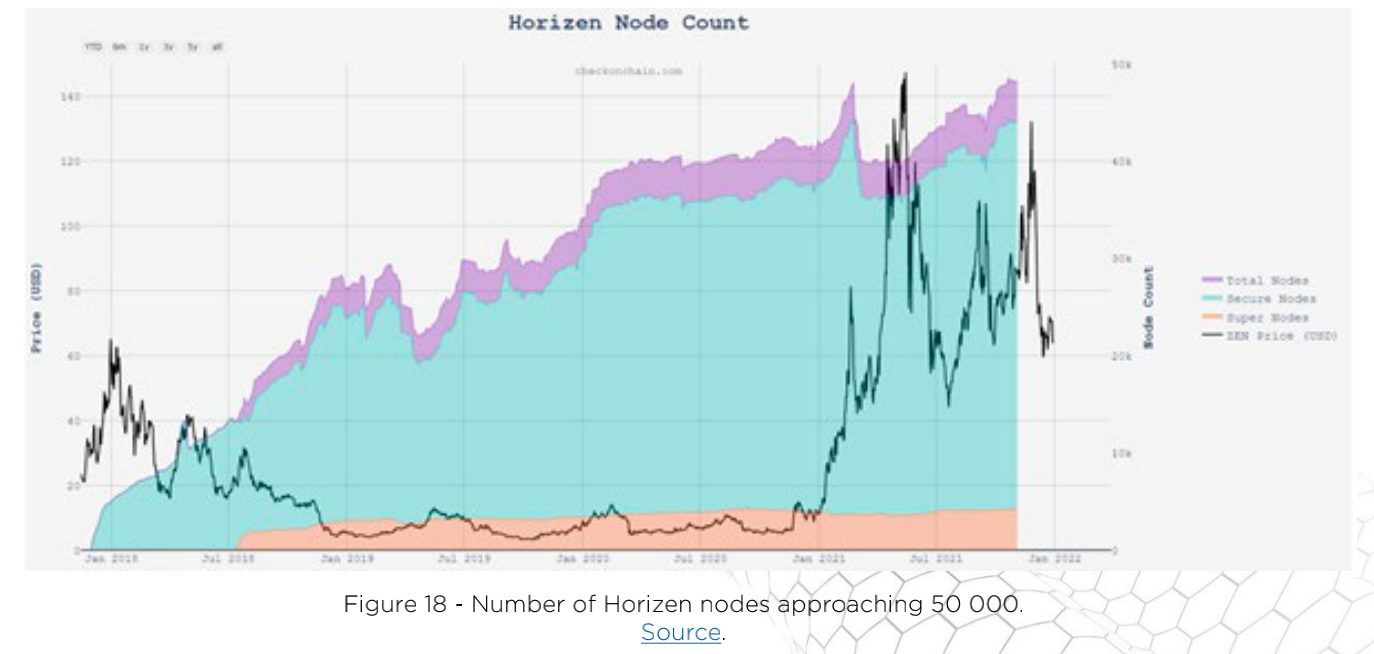
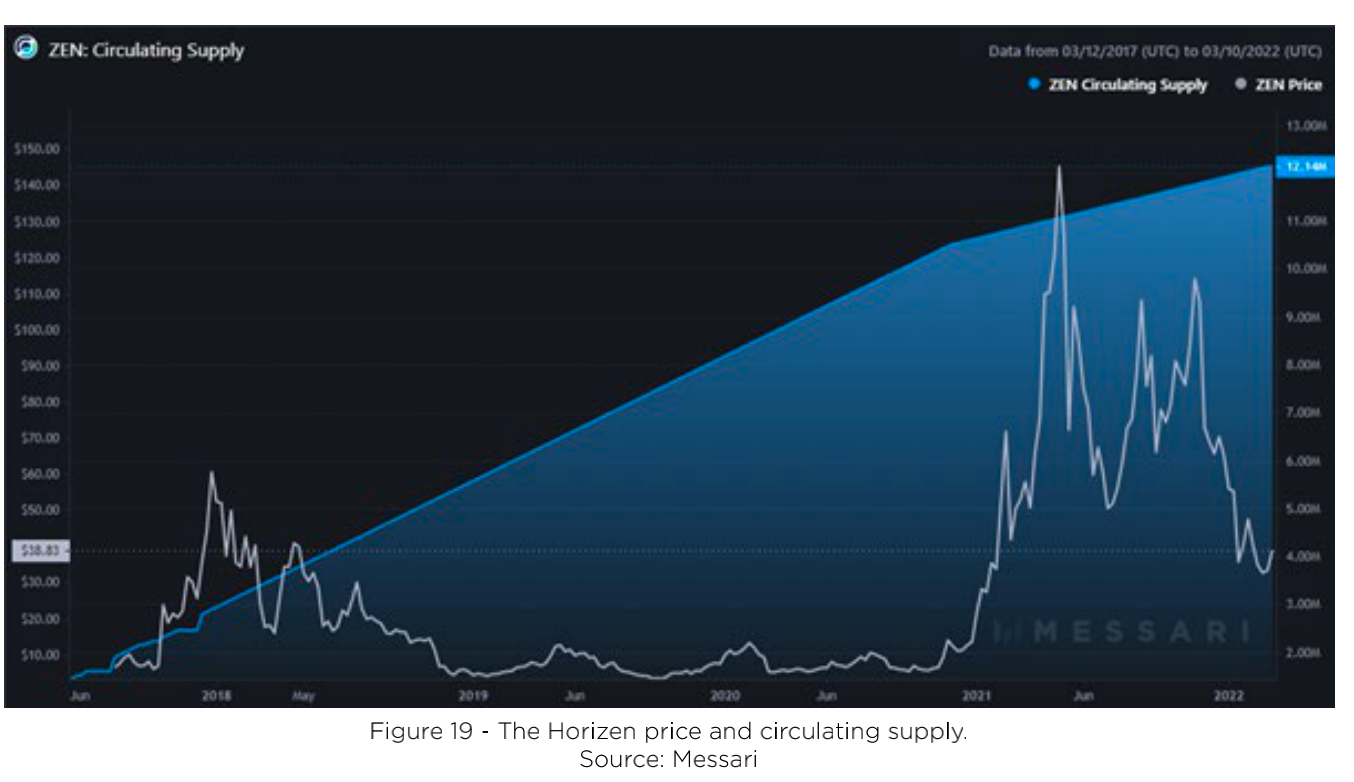
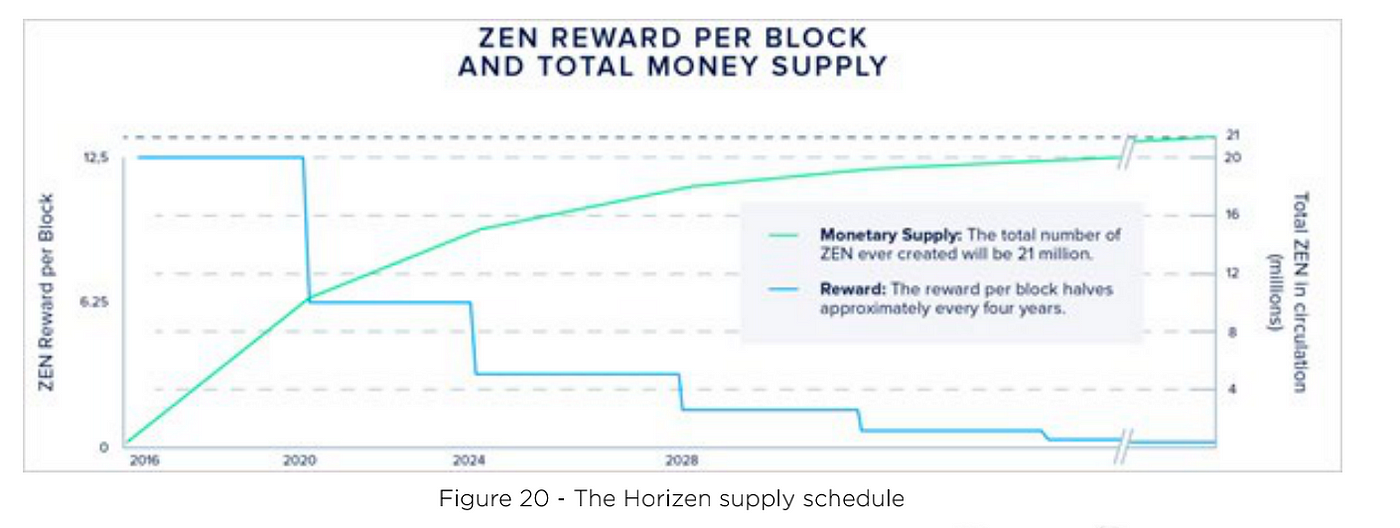
The Zen tokens can live in 2 different places: the T-addresses which are regular public addresses (just like Bitcoin for example) and Z-addresses which are the privacy addresses. The transactions between Z-addresses are private and anonymous.
To manage ZEN, Horizen offers the Sphere wallet, which supports the 2 types of addresses above and it even has a cool chat feature that allows users to send encrypted messages through the blockchain. Other than Sphere, Horizen is also supported by many tier 1 wallets like Ledger, Coinomi, Abra and others.
ZEN also has a list of merchants and payment gateways accepting it (which is uncommon and a good differentiator when compared to the other projects that we have looked into in this research).
Governance
Horizen uses the Horizen Improvement Proposal System (ZenIP) in order to push protocol upgrades and any major changes to the network. Developers can propose new ideas by creating a pull request against the ZenIP repository. After being discussed, voted and tested, the proposal can finally be activated on Horizen’s mainnet.

Projects building on Horizen can also use the voting system that was implemented by the network in collaboration with IPHK and leverages zk-SNARKs. It basically allows for secret voting and Zen holders vote is weighted according to the locked up stake value. Users can either vote directly or similarly to a representative democracy, they can delegate their votes to an “expert”.
In addition, Horizen also has a Community Council that organizes and brings topics to the Zen Blockchain Foundation.
DeFi ecosystem
Horizen is yet to have the capabilities to build the DeFi ecosystem. The tokenization platform is at the time of this writing on testnet. It is scheduled for H2 2022 for the network to kick off the DeFi applications on the network.
Network challenges
- EVM compatibility hasn’t been deployed yet
- The DeFi ecosystem is yet to be tested
- Incumbents
Phala Network
Overview
The Phala Network was born in Beijing and it tackles the issue of trust in the computation cloud. It aims to be a cloud computing network that offers cloud computing services like Microsoft Azure, AWS and Google Cloud but built on the web3 tenets of trust and decentralization.
Phala implements a confidential smart contract built on TEE-based privacy technology embedded into processors compatible with TEEs such as the Intel SGX, so that the data transfer and computational cloud can run on the confidential layer. Phala Network is also a Substrate-based interoperable cross chain confidential smart contract platform, and as a member of the Kusama (KSM) parachain. The network it will be able to provide computational power for other blockchain applications with protecting the data layer enabling possibilities that run across privacy protection, DeFi, trading positions and transaction history.
It is safe to say that the Phala Network is also the first Smart Contract platform to provide a token bridge collaboration with Bitcoin Gold.
The technology
The Phala Network can be considered an innovation for Web3 that combines a few technologies that ensure a trustless cloud-based computing with many potential use cases.
Similarly to the Secret Network, Phala also run confidential smart contracts. Both rely on hardware enclaves, using Intel SGX TEEs. However, while Secret is part of the Cosmos ecosystem and relies on its own Cosmos based network for the consensus layer, Phala relies on Polkadot. Another important difference in the Phala architecture is that Phala adopted a rollup architecture, separating the consensus layer and the computation/execution layer.
Currently, Phala is using the Khala network, which is a Kusama parachain (Kusama is Polkadot’s canary chain). Phala recently won a Polkadot parachain (March 31, 2022) and it will transiction to it sometime in 2022.
Phala’s network is capable of scaling the computation capacity, aiming to potentially complete with other big cloud providers like AWS, Azure and google Cloud. Although far from offering the range of services offered by traditional cloud providers, Phala has around 30 000 vCPUs (virtual CPUs) that are provided by approximately 23 000 workers. These workers are computers that join the network to provide computation power to the network. This is also referred to as “Secure Worker Mining”.
To be one of these workers/miners, the participant is required to have a computer equipped with Intel SGX.
This computation layer where Phala’s fat contracts take place. In Phala’s terminology, fat contracts are not smart contracts. Instead, they are basically the layer where dApps can have access to the decentralized cloud computing network that is provided by the miners. The fat contract layer allows dApps to have access to real-time, low latency compute power, and access to internet services.

Phala also has a network of gatekeepers that are responsible for the block production and key management. These gatekeepers need to stake PHA and they are elected on blockchain by NPoS — Nominated Proof of Stake — mechanism similar to Polkadot. Gatekeeper’s stake and reputation may be slashed for misbehavior or downtime.
Phala is built and connected to Polkadot via Substrate framework for building customized blockchains much easier. In fact, Substrate was built out of Polkadot’s codebase.
Parity, the company behind Substrate also built the Polkadot network which is a decentralized, protocol based blockchain platform for enabling secure cross-blockchain communication. Polkadot can be seen as a means to network between blockchains, taking care of the communication problem even between systems and probably helping Phala’s interoperability in the future.
Social media and community
Although smaller, the Phala seems to be active and quite helpful on their Discord channel. The following links are where to connect with the Phala community and learn more about their network.
Twitter — 119,000 followers
Medium — 2,100 followers
YouTube — 4,600 followers
Telegram — 26,000 followers
Discord — 5,300 followers
Milestones for 2022
In recent activities and reports from the project, a few projections were stated: “In 2022, Phala will concentrate on mainnet launch, product optimization, and ecosystem growth. We are excited to show you our vision and goals on Fat Contract and Web3 cloud etc.”
Also, further reports show that the Phala team is looking to work on the following:
● Win a Polkadot parachain and migrate from Khala (Kusama) to Polkadot mainnet
● Updates to the Phala networks and PRuntime
● Phala World; A community Metaverse built on the Phala network
● Render services for 3D NFTs in collaboration with Blender
● Expanding the Wb3 cloud infrastructure to include additional services, including decentralized storage integration
● AMD SEV integration — to reduce the dependency on Intel SGX
● Continue expanding fact contracts scalability
● Phala World — Phala World’s NFTs — a Metaverse/NFT game to bring the Phala community to the metaverse
Token economics
The native token for the Phala Network is PHA. Only about 272,000,000 PHA tokens are currently in circulation, and more tokens are gradually being released to the community through mining, airdrops, and sales.
According to its whitepaper, the economics the Phala network was built on was on the basis of addressing the following point:
**1. **Supporting trustless cloud computing architecture: this can be up 100,000
workers/miners (23 000 at the time of this writing)
**2. **Incentive miners to join the network: pay miners for power supplied irrespective of demand at network bootstrap
**3. **Incentivize on-chain performance
**4. **Governance: PHA is the native utility token of Phala Network and is used for a security guarantee, governance, purchasing trusted computing resources and data exchange fees.
The distribution of this token is as follows:
• TEE miners: 70%
• Private Sale: 15%
• Ecosystem Building & Parachain Auction: 9%
• Team Incentive: 5%
• Testnet Incentive: 1%
Governance
Users are expected to hold a certain amount of PHA token to be able to join the Phala DAO and participate in the community voting, decision making and proposals. These stakeholders manage the Phala/Khala network and community. Khala is the pre-mainnet for Phala network, it helps to catch on problems and failures early enough before the mainnet launch.
The Phala network is yet to be launched into mainnet hence the Khala network will use the Polkadot and Kusama for their governance mechanism. This ensures the DAO activities are accessible to the blockchain network and stakes are commanded.
In order for this to happen, active stakeholders (the community) council members and technical members will weigh in to make sure the majority of the stakes can command the state of the network. Even though the proposal will be submitted by the public or council members it will have to go through a voting process to let all stakeholders make a decision.
Dero Network
Overview
Dero brings to the crypto space innovative ways of keeping data private and it’s definitely a trailblazer when it comes to data encryption. Dero is a general-purpose, private and scalable decentralized application platform that allows developers to deploy dApps that let users retain total control over their assets with complete privacy. Dero achieves this by using homomorphic encryption.
Dero has been developed from scratch in Golang by three anonymous developers and is still being actively developed by the 3 original anon developers. Dero’s developer team seems to have the experience in cryptography and multiple years of experience in blockchain development. However, the developer community and activity seems to be currently small.
Launched in 2017, Dero is a homomorphically encrypted protocol that can serve both individuals and businesses worldwide, with fast and anonymous transactions (up to 750 tps), smart contracts written in BASIC, and a service model.
Dero’s objective is to provide high grade privacy tools and private networks to the general public with commonly available CPUs and hardware in the market and not depending on any specific hardware. To do this, Dero uses the AstroBWT mining algorithm which can run on any CPU. In fact it seems that the majority of the Dero community is mining Dero on regular CPUs, without the need for specialized ASIC miners due to Dero’s ASIC resistant algorithm, which is good for decentralization.
The technology
The common consensus in the crypto market is usually proof of work, proof of stake, and some times Directed Acyclic Graphs (DAG) and respective variations. Proof of work blockchains focus on security at the cost of speed (Bitcoin is an example of this, with an average block time of about 10 minutes) while DAG block structure offers increased speed at the expense of security.
Dero was initially written in Golang but later on, the Atlantis codebase was then developed and the project migrated to the Atlantis codebase which decreased the block time and made transactions much faster.
Dero is a hybrid blockchain, with an average block time of about 18 seconds. It is the first blockchain protocol to employ the integration of the proof of work mechanism with Directed Acyclic Graph block structure while ensuring anonymity.
To achieve confidentiality, Dero is homomorphically encrypted. A typical blockchain stores all information on the chain in clear text and uses a UXTO model but Dero uses a unique encrypted blockchain with an account-based model, thus creating a secure and private network. This homomorphic encryption is what makes Dero different when compared to other privacy networks discussed in this report.
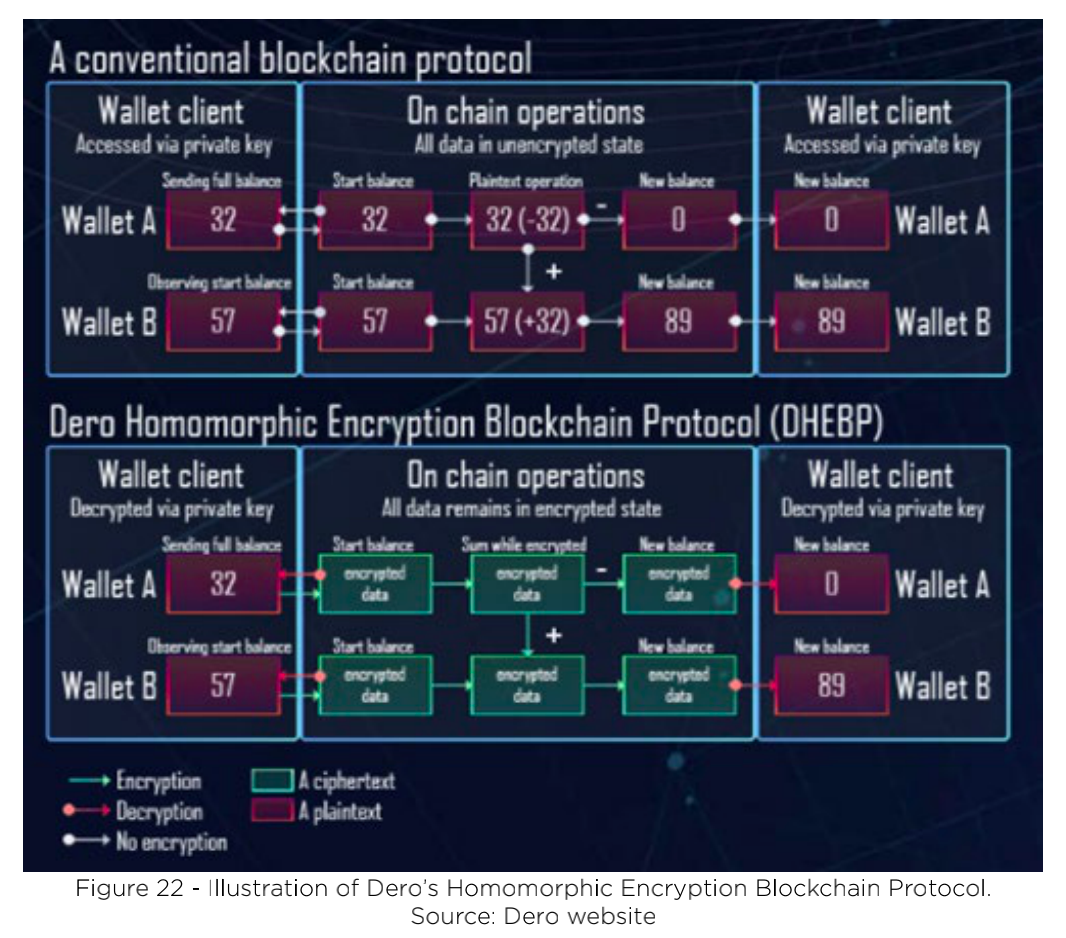
By now, you may be asking “What the heck is homomorphic encryption?” Homomorphic encryption or HE is a type of encryption that allows users to perform computations over encrypted data without requiring access to a decryption key. The resulting computations remain encrypted and all the data on the blockchain is encrypted. All this happens without depending on specialized hardware or TEE — Trusted Execution Environments — used on Secret Network or Oasis.
Homomorphic encryption can be used to preserve the privacy of any or all the data stored on the network’s nodes. This can be a good alternative to TEEs and ZK-snarks. It’s a highly researched technology but it seems to be the least adopted when it comes to achieving privacy in the crypto space.
Dero Homomorphic Encryption Blockchain Protocol (DHEBP) is a new protocol (and the first that we have seen until now) used for scalable confidential transactions and private smart contract execution. It is decentralized, private, and scalable. The DHEBP employs an account-based structure that removes the requirement for scanning UTXOs, which allows wallets to provide instant balances to users.
Dero is the first blockchain project to use self-signed TLS encryption for its network communication. Dero also utilizes UDP for peer-to-peer communication instead of TCP. This means that there’s end-toend encryption and all the data-in-transit is encrypted all the time.
Dero is also the first smart contract network using CryptoNote. CryptoNote has been used to improve the privacy of coins such as Monero, Bytecoin, Aeon coin, Karbo and DigitalNote. Through the use of CryptoNote, Dero never reveals the identity of the sender and recipient of a transaction, ensuring full anonymity. Account balances and data cannot be decrypted by the blockchain. Only whoever has the account can access and decrypt their data.
In summary, if I send a transaction, which is a basic Dero transfer or coin transfer from my wallet, my wallet encrypts this transaction before broadcasting it to the network. Note that this is an exception to most of the blockchain networks. Typically, in public blockchains, there’s a lot of cryptography going on but it’s mostly related to digital signatures and hashing and not so much with data encryption.
Through some cryptography magic, the transactions can be verified without decrypting the data. Homomorphic Encryption never decrypts the data and no one can see who is receiving or who is sending, or even what kind of transaction was sent. Only the send and recipient of the transaction have access to it.
Social media and community
The DERO project keeps users informed as often as possible while still providing newsworthy information. Although smaller, the Discord community is fairly active.
Twitter — 12,000 followers
Reddit — 2,000 followers
Telegram — 4,300 followers
Discord — 4,900 followers
Milestones for 2022
The DERO team has achieved some major milestones since the project’s inception. These include:
- Creation of the Dero foundation
- Listing of the coin on larger exchanges (Kucoin)
- Increasing exposure with help of notable industry players, mining pools, and community efforts
- Security auditing
In March 2022, the Stargate upgrade with private smart contracts and services launched on mainnet, now enabling smart contracts on the network. Stargate also included software upgrades and a new wallet. This was a major milestone for Dero and it’s likely to unlock new use cases for the network, as well as bring more developers to develop new dApps.
Use cases and ecosystem
There are many potential uses cases for the Dero protocol. However, considering that the smart contract functionality was only implemented recently, the dApp ecosystem is still small.
Token economics
The DERO coin is the means of exchange within the network and just like most smart contract blockchains, it is also used to pay network fees related to the smart contracts.
The Dero coin supply resembles Bitcoin: it is hard capped at 21 million coins and the block reward halves every 4 years. There’s an interesting difference when compared to Bitcoin: on Dero, all the rewards are shared with all the miners, as if all the Dero miners are part of a big mining pool. Additional Dero stats can be seen here and here.
Governance
Developers usually submit proposals for blockchain improvements and a core group of developers will coordinate consensus between stakeholders. Governance is on-chain.
Conclusion
Most of us agree that privacy is important, Considering that we are moving our finances and assets to the Web3 space, we will need blockchain protocols that ensure that level of privacy.
Most likely, none of the networks analyzed in this report will be the “Ethereum killer”. That’s not the goal. The goal is to create networks that allow assets, people and smart contracts to interact with a layer of privacy.
All these technologies Secret, Oasis, Horizen, Phala, Dero, try to tackle the privacy issue in unique ways. From using TEEs, zero-knowledge proofs and homomorphic encryption, they all use complex encryption methods in order to protect user’s privacy. They have all designed and implemented beautiful cryptographic solutions. However, they are also in different development stages. While Secret and Oasis already have their respective DeFi ecosystems that have been attracting higher TVLs and higher market capitalization, Horizen, Phala and Dero still have to prove that they can build DeFi applications and other dApp use cases on the top of their networks.
Secret and Oasis seem to have proven the capability to develop a number of use cases on their networks and consequently, they may be seen as lower risk investments. Their market capitalization was at the time of writing this report around $1 billion and if we continue to see the crypto space leaning towards privacy, these 2 protocols are in very good position to be serious contenders to lead the privacy space. This happening, we could see enough growth to put them on the top 20 cryptocurrencies by market capitalization, which could probably represent a 10x growth from the current levels.
What about Horizen, Phala and Dero? Their technology seems solid, but their dApp and DeFi ecosystem is not visible yet. They still need to prove to be able to attract developers, dApps and DeFi but in doing so, their growth potential could be even bigger.
Disclaimer
The information contained in this document has been compiled by HashKey Group (as defined below)from sources believed to be reliable, but no representation or warranty express or implied is made by HashKey Group, its affiliates or any other person as to its fairness, reasonableness, reliability, accuracy, completeness or correctness. All illustrations, examples or forward-looking information (if any) contained in this document have been provided in good faith for illustrative purposes only as of the date of this document, and are not intended to serve as, and must not be relied upon as, a guarantee, an assurance, a prediction or a definitive statement of fact or probability. Whilst efforts are made to ensure the accuracy and completeness of the information contained in this document at the time of publication, errors or omissions may occur. Past performance is not a guide to future performance, future returns are not guaranteed, and a loss of original capital may occur. HashKey Group reserves the right to correct any errors or omissions, and to change or update information at any time without prior notice.
Each legal jurisdiction has its own laws regulating the types of investments and/or services which may be offered to its residents and/or in its jurisdiction, as well as the process for doing so. As a result, certain investment products or services discussed in this document may not be eligible for sale or offered in some jurisdictions. This document is not an offer to sell or a solicitation of an offer to purchase any investments or services. Unless otherwise specified, HashKey Group does not hold itself out to be licensed to carry on regulated activities in any jurisdiction. Additionally, providing this material is not, and under no circumstances should be construed to act as a regulated business in any jurisdiction by any person or company that is not legally permitted to carry on such regulated business in that jurisdiction. Nothing in this document constitutes legal, accounting, or tax advice, and you are advised to seek independent legal, tax and accounting advice prior to acting upon anything contained in this document. The contents of this material have not been reviewed by any regulatory authority. Investors are advised to exercise caution in relation to any investments or services in relation to this document. If you are in doubt about any of the contents of this material, you should obtain independent professional advice. To the full extent permitted by law, neither HashKey Group nor any of its affiliates, no any other person, accepts any liability whatsoever for any direct or consequential loss arising from any use of this document or the information contained herein. No information contained in this document may be reproduced or copied by any means without the prior written consent of HashKey Group.
“HashKey Group” is a brand name to describe any one or more entities of the group companies composed of HashKey Digital Asset Group Limited and its Affiliates.